#legacy: rigby
Explore tagged Tumblr posts
Text
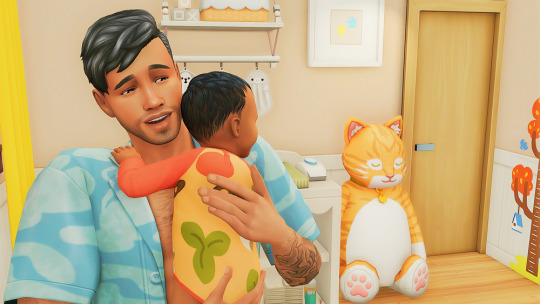
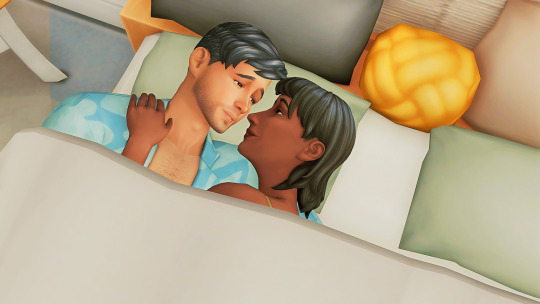
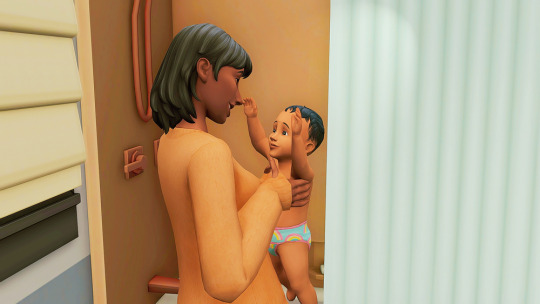
reconnecting
#ts4#sims 4#sims 4 maxis match#ts4 maxis match#ts4 gameplay#sims 4 gameplay#legacy: rigby#clementine rigby#lucian rigby#sebastian rigby#legacy challenge
7 notes
·
View notes
Text
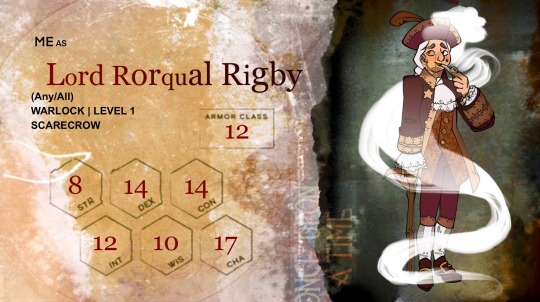
Haven’t done one of these in forever but he’s fun and I wanted to draw them.
Template is from @poncivalpishpuff and Giuseppe Lama
#Rorqual is another name for the Razorback whale and Razorback is the trail that gets you up Feathertop Mt in Australia#it’s very convoluted but it’s cute#again ‘scarecrow’ is a reskin#he’s an undead but his ancestral legacy is that of a warforged#plot wise he was going back to Mother Rigby’s home to return her pipe and give up on life#but found evidence of a horrible struggle instead#as awful as he finds being a facsimile of a human to be#he’s certainly not willing to abandon his mother#unfortunately his only remaining magic is whatever the fiend Dickon she entrusted to him can muster#and it’s eating away at his illusion of life#my art#Neverafter oc#neverafter d20#my ocs
5 notes
·
View notes
Text
(Playlist in progress. Songs will be added as new scenes of Jayce and Viktor are shown.)


Continue reading to find out why the songs were included.
Eleanor Rigby is a song about death and the legacy of a life that went unnoticed. I believe the song is an excellent fit for Zaun and Viktor's storyline from Season 1.
Evolution Once Again, My Body is a Cage, and Run describes the growing rift between Viktor and Jayce. With romantic connotations. One-sided. Yeah. I am here to break your heart.
Those Were the Days is a song originally from Russia. It is about the narrator's past youth and naivety, as well as the inability to recognize who you or your friends have become. The song is brimming with nostalgia, which fits the scene of Jayce and Viktor reminiscing about the past in the iron fortress.
As the World Caves In is the finale of Season 1 and Jayce's desperation to save his life.
Son of Nyx is a reference to Charon, who transports souls through the River of Styx in the Underworld of Hades. Its instrumentals matched Viktor's eerie chrysalis and Jayce's demeanor as his partner approached death. The sudden shift in melody is Viktor coming out of his cocoon.
Goliath's instrumental is for the Hexcore. Meanwhile, the lyrics describe the narrator's relationship falling apart while their partner pretends nothing is wrong.
Exogenesis, in both parts, fits perfectly with Viktor's new Jesus storyline. The first part is about existential crisis. The second part is becoming the savior, with no way back.
36 notes
·
View notes
Text
TEAM THUNDERDOME.
TWO TEAMS ENTER. TUMBLR VOTES. ONE TEAM LEAVES. TRIAL BY COMBAT. TO THE DEATH. VICTORY OR SOVNGARDE.
The Rules:
Fights will occur over the course of ONE WEEK, quarter 1 begins JUNE 1ST, 2024 at 12:00 AM MIDNIGHT EDT (UTC-04:00).
Multiple fights happen across one week.
ONLY 3 to 4 team members per team. 2 is too few, 5 is almost cheating. If a team has more than 4 members, some will have to wait in the stands (looking at you, Scooby-Doo and Tally Hall).
Tumblr poll will determine the winner of an individual fight via emotional support and gracious cookie donations.
Majority Wins. Whether or not a team would canonically win or lose the fight does not matter, only the number of votes.
Single Elimination.
Outside of the rules listed above, anything goes. Reblog a fight to get your friends on your side.
Propaganda is fair game. If you know perhaps a little too much about one of the teams and want to explain why your team should win, please submit an in-depth propaganda post to the blog homepage.
Spread the word! Your favorite might win! (Or not! I just run this thing!)
Lasko Wind Machine
All 64 Teams Competing (In random order - will NOT reflect the final bracket):
Team WINCHESTER (Sam, Dean, Castiel, Crowley)
Team FORTRESS (Heavy, Medic, Engineer, Soldier)
Team AIONIOS (Noah, Lanz, Eunie, Riku)
Team GONDOR (Aragorn, Legolas, Gimli, Gandalf)
Team TWILIGHT (Jacob, Edward, Bella)
Team STAR WARS (Han, Luke, Leia, Chewbacca)
Team NARUTO (Naruto, Sasuke, Sakura)
Team SHREK (Shrek, Fiona, Donkey, Puss In Boots) (As portrayed at the end of Shrek 2)
Team OF LIGHT (Jonathan Harker, Jack Seward, Quincey Morris, Abraham Van Helsing)
Team PERSONA (Makoto Yuki, Kotone Shiomi, Yu Narukami, Ren Mamamiya)
Team HOMESTUCK (John, Jade, Rose, Dave)
Team MUSKETEERS (Athos, Porthos, Aramis, D'Artagnan)
Team HERCULES (Hercules, Iolaus, Salmoneus, Autolycus) (The Legendary Journeys, Hercules as portrayed by Kevin Sorbo)
Team PUYO PUYO (Ringo, Arle, Amitie, Lemres)
Team BAKUGO (Bakugo, Mina, Denki, Eijirou)
Team WIGGLES (Jeff, Anthony, Murray, Greg) (as originally formed)
Team GRYFFINDOR (Harry, Ron, Hermione)
Team COOL RUNNINGS (Derice Bannock, Junior Bevil, Sanka Coffie, Yul Brenner)
Team AEGIS (Rex, Pyra, Mythra) (all other party members excluded due to Blades and their pesky "friendships" binding them to their users)
Team RHYTHM THIEF (Raphael, Fondue, Marie, Charlie) (what a cute doggy :3)
Team MYSTERY INC (Fred, Shaggy, Velma, Daphne) (sorry no pets allowed)
Team DEKU (Izuku, Tsuyu, Ochako, Shouto)
Team KRISPIES (Snap, Crackle, Pop)
Team ELITE BEAT (Agent Spin, Agent J, Agent Chieftain, Agent Starr)
Team JIGSAW (Kramer, Young, Hoffman, Gordon)
Team UMIZOOMI (Milli, Geo, Bot)
Team TRIFORCE (Link, Zelda, Groose) (Skyward Sword variants)
Team LAYTON (Layton, Luke, Emmy) (Pre-Azran Legacy)
Team SONIC (Sonic, Knuckles, Tails)
Team ASKR (Alfonse, Anna, Sharena)
Team TARDIS (The Doctor, Amy, Rory, River)
Team WOOHP (Sam, Alex, Clover)
Team KEYBLADE (Sora, Donald, Goofy)
Team 1908 THOMAS FLYER (Montague Roberts, George Schuster, Hans Hendrik Hansen, George MacAdam)
Team BIONIS (Shulk, Reyn, Dunban, Sharla)
Team DARK (Shadow, Rouge, Omega) (Ultimate Life Form status tenuous)
Team OOO (Finn, Jake, Princess Bubblegum, BMO)
Team TALLY HALL (Rob, Zubin, Andrew, Joe) (Ross excluded - he's just a drummer)
Team DOODLEBOPS (Deedee, Rooney, Moe)
Team SCIENCE (Gordon, Tommy, Bubby, Dr. Coomer)
Team POWERPUFF (Blossom, Buttercup, Bubbles)
Team INCONCEIVABLE (Inigo, Fezzik, Vizzini)
Team METROCITY (Megamind, Metro Man, Roxanne, Minion)
Team WONDER PETS (Linny, Tuck, Ming Ming)
Team REGULAR (Mordecai, Rigby, Muscle Man, Skips)
Team PILLAR MEN (Santana, Wham, ACDC, Kars) (Ultimate Life Form status tenuous)
Team BEATLES (John, Paul, George, Ringo)
Team SMILING FRIENDS (Pim, Charlie, Glep, Alan)
Team ROTTEN (Robbie, Tobby, Bobby, Flobby) (Ultimate Life Form status confirmed)
Team KRUSTY KRAB (SpongeBob, Patrick, Squidward, Mr. Krabs)
Team VOCALOID (Hatsune Miku, Kagamine Len, Kagamine Rin)
Team GARFIELD (Garfield, Jon, Odie, Liz)
Team POOH (Pooh, Piglet, Eeyore, Christopher Robin)
Team AVALANCHE (Cloud, Tifa, Aerith, Barret)
Team LOONEY (Bugs Bunny, Daffy Duck, Porky Pig, Michael Jordan)
Team GHOSTS (Blinky, Pinky, Inky, Clyde) (freshly dead)
Team ROCKMAN (Rock, Roll, Blues, Bass)
Team MARIO (Mario, Luigi, Wario, Waluigi)
Team WRIGHT (Phoenix, Apollo, Athena, Trucy) (as seen in Dual Destinies)
Team SHERLOCK (Sherlock, John, Mycroft) (Brigandorf Crimplesnart's depiction of Sherlock)
Team MASH (Benjamin Franklin "Hawkeye" Pierce, BJ Hunnicutt, Charles Emerson Winchester III)
Team RWBY (Ruby, Weiss, Yang, Blake)
Team CHANNEL 5 (Ulala, Space Michael, Jaguar, Pudding)
Team FANBOY (Fanboy, Chum Chum, Kyle)
GOOD LUCK!!!
(you're gonna need it)
#TEAM THUNDERDOME#tumblr bracket#bracket tournament#supernatural#doctor who#team fortress 2#m*a*s*h#mash#space channel 5#rwby#the doodlebops#the wiggles#bbc sherlock#ace attorney#super mario#pac man#final fantasy vii#looney tunes#garfield#winnie the pooh#vocaloid#spongebob#spongebob squarepants#mega man#rockman#lazy town#robbie rotten#the beatles#pillar men#jojo's bizarre adventure
17 notes
·
View notes
Text
Ostagar, Part III: The Korcari Wilds and its Witches
Last, we need to talk about the history of Ostagar and the surrounding Korcari Wilds.
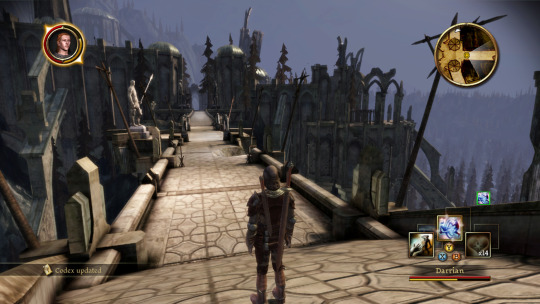
Per the codex, Ostagar is an old fortress from the days of the Tevinter Imperium. Its purpose was to be a bulwark against aggression from the Chasind, another human tribe like the Alamarri that would form Ferelden and the Ciriane that would become Orlais.
Tevinter built this massive fortress but then they didn't have it for very long. Beginning in 7205 and raging for two centuries, the First Blight drove Tevinter out of the southern lands.
Dumat's war cost Tevinter control of the south, and allowed the Alamarri, Ciriane, and Chasind to consolidate their power in those regions. Eventually culminating in the Alamarri Andraste's rebellion against Tevinter.
Ostagar came into the possession of the Chasind. They would retain control of it for about seven or eight centuries until the unification of Ferelden under King Calenhad resulted in the Chasind being driven further south.
For the next four hundred years, the fortress sat there and rotted. Until King Cailan and Teyrn Loghain decided to use it as a staging ground for their plans against the Fifth Blight.
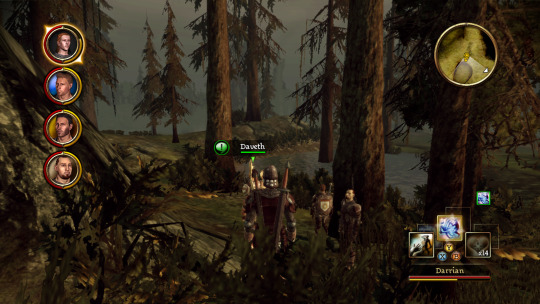
There's not a lot to say about the Wilds themselves. By definition, they are a place where not a lot of history that we know about has happened. This is a region of Thedas occupied by the "wilders", as Fereldans call them. Which means the Chasind.
The Fifth Blight began way out here, on the outer edge of the formally acknowledged civilizations. Urthemiel, Old God of Beauty and the avatar to the Evanuris June, God of Crafts, was awakened somewhere deep beneath these woods. They were able to amass out here with only the Chasind being the wiser, and the Chasind don't really talk to the other nations.
A minor story in the Wilds concerns this unfortunate dipshit.
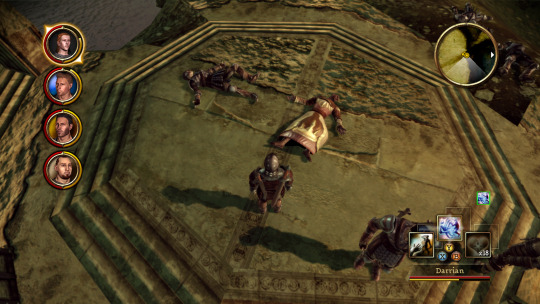
Missionary Rigby might just have been the first Fereldan to discover the Blight. This poor bastard is an Andrastian Missionary who came out here trying to spread the Chant of Light to the Chasind.
It did not go well. He never found the Chasind, as they had already fled the area to escape from the growing Blight. At the same time he was trying to unpack what happened to the Chasind, he received word that his son Rigby had become a missionary and was coming out to join him.
He initially sent Rigby some light admonishment for picking the Korcari Wilds of all places for his first mission, but left him instructions on where they'd meet up. He would soon come to regret that mistake.
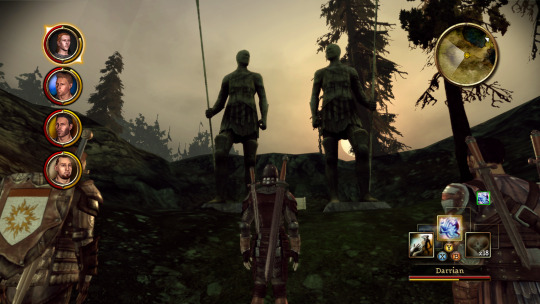
These statues were supposed to be their meeting point inside the Wilds. But instead, all that's waiting here is a weapon and a note to Jogby, warning him to grab the weapon and get the fuck out. By this point, Rigby knew he wasn't making it out alive, and left everything he had for Jogby.
Jogby never even made it this far.

His body is one of the first things you find in the Wilds. The Darkspawn killed him before he'd barely even set foot in this place. The Blight is a bad time to go wilderness hiking.
But don't go feeling too bad for Rigby. He could have left once he realized the Chasind were gone, but he lingered in this place because he got greedy.
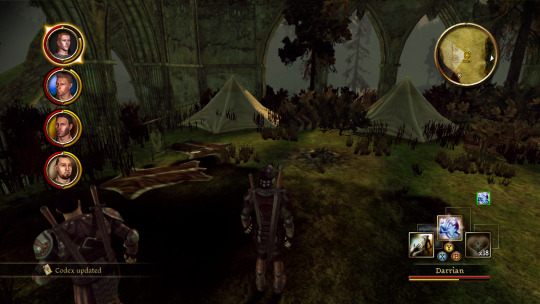
At Rigby's encampment, his journal explains what he was still doing out here. He found Chasind markings suggesting some sort of treasure cache in the area. And he figured, hey, the Chasind aren't around so....
Yeah, Missionary Rigby died trying to capitalize on the Blight to loot Chasind coffers. His body is lying about halfway down the path. It's just a shame his son had to die for that too.
It's disgusting. Fortunately, I am a member of a proud and noble legacy of heroism and virtue, and would never stoop so low as to--

...look, man. It's the Blight. The Wardens need to pursue every avenue for supplying our forces that we can!
Ehehe... Hehehe....
Armies are fucking thieves. In fact, there's another little sub-story happening in these woods and it concerns this dipshit.

This is Markus. He was killed by Darkspawn before he had his chance to be killed by stupidity. Looting his corpse reveals a pinch of ashes and the story of star-crossed love.
See, there was this woman Astia who was friends with a spirit named Gazarath. Odd name for a spirit, as they're typically named for whatever particular concept they embody, but we can roll with it. Maybe Gazarath is what Astia named him.
Anyway, love triangle shit happened. Astia loved a man named Nebbunar, which enraged Gazarath because Gazarath loved Astia. Gazarath demanded that Astia murder Nebbunar or their friendship was fucking over.
Astia did so, slitting Nebbunar's throat on their wedding day and bringing his ashes to Gazarath as proof. The. Uh. The legend is conspicuously silent about what happened to Astia after that.
But it does say that if you bring Gazarath ashes, he'll grant you a wish! That sounds plausible!
If you feel like being unbelievably stupid, you can try it out for yourself.

Holy shit, it works! One wish, please! ...no? Just violence? Okay.
But obviously, the stars of the Korcari Wilds section of the game are the Witches of the Wilds themselves.
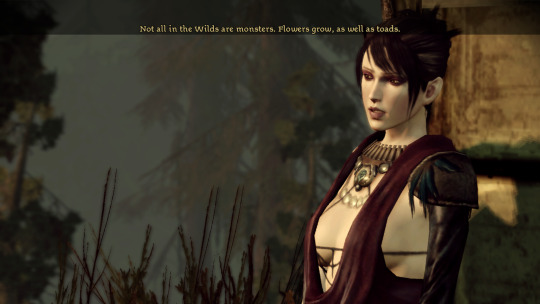
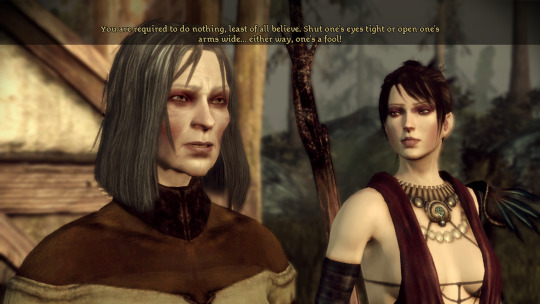
Morrigan and Flemeth are basically the face of Dragon Age. In a sense, the myth arc that's transpired across the four games has been their story, playing out in the background until its conclusion in Veilguard.
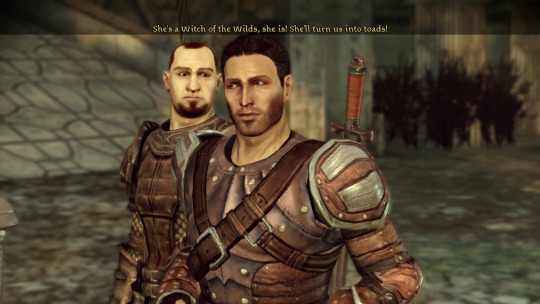
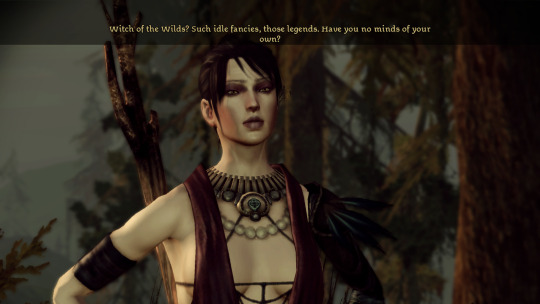
It's honestly funny that Morrigan dismisses the superstitions around the Witches of the Wilds. Because. Like.
Morrigan is a shapeshifter adopted by a fragment of an elven goddess that immortalized herself by passing from body to body. At the end of this game, she may or may not perform a magic ritual to safely reincarnate the soul of an Evanuris and spare the Grey Wardens from the price of slaying the Archdemon, which is a feat of magic unthinkable to literally everyone else.
There's a lot of sincerely weird shit going on with Morrigan and Flemeth that's way outside the realm of ordinary magic as it's recognized in Fereldan society. They are on a completely alien level when it comes to weaving impossible sorceries drawing on esoteric forces unknown to the denizens of Thedas.
But turning people into toads is the line she wants to draw. Okay.
Of course, Morrigan is immediately meant with suspicion and hostility despite the fact that she's literally just here to offer the Wardens their treaties back.
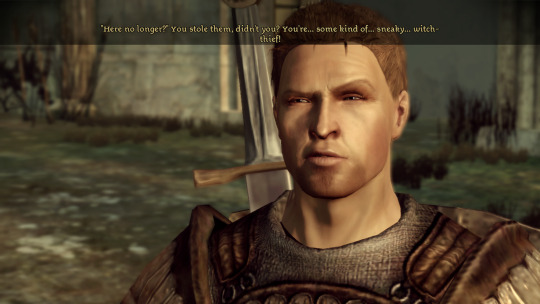

Alistair's right to be suspicious, but he's wrong to be suspicious. Morrigan and Flemeth are playing the Wardens but....
Well....
It's kinda like when you hide a pill inside a hot dog and give it to your dog. You're tricking the dog, but it's for the dog's own good.
Or, to quote Jory and Daveth:

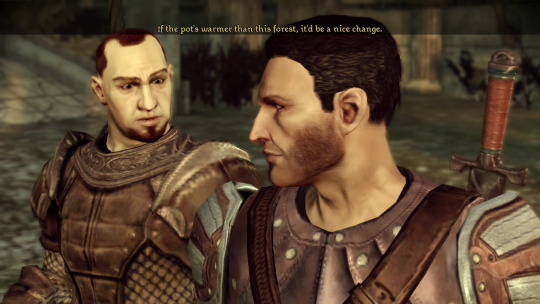
The pot is so much warmer than this forest. You have no idea.
Alistair immediately suspects the Witches of having broken into the Warden ruins and stolen their treaties from a sealed chest. Flemeth tells a different story.
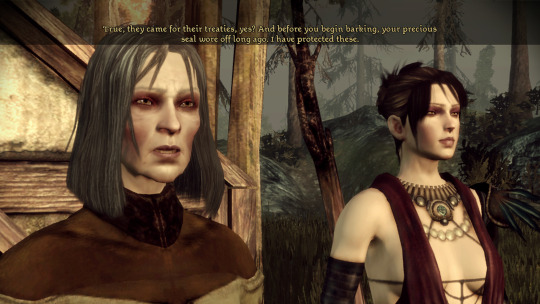
This is probably a lie. The chest that the treaties were supposed to be in looks to have been broken open by force, which seems odd if the seals merely broke on their own. Supposedly, only a Grey Warden could break into the chest, but Mythal's powers are vast and esoteric.
Flemeth seems to have a capacity for future sight. She already knows much of how the Blight will play out, even telling Jory to his face that he's inconsequential. She and Morrigan are turning the wheels of their preferred endgame, and so it seems likely that Flemeth did break into the chest in order to give the Wardens a reason to come to her.
Again: We are being played. For our own good.
Morrigan and Flemeth's sinister endgame is to retrieve June's soul from Urthemiel in such a way that the Blight ends, June goes free, and no Warden has to be extinguished to do it. They are manipulating the Wardens to achieve good things for everybody, and the only drawback is that June's soul ends up in the hands of suspicious people.
We all get the happiest possible ending, but what is that woman going to do with the God Soul? We don't know. And neither do the writers because the answer ends up being nothing whatsoever.
Morrigan is eerie, but it's just a vibe. She's basically the overarching protagonist of this entire franchise.
She will express terrible opinions all the time.
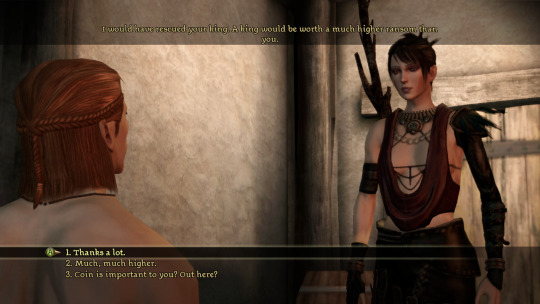
She's kind of an asshole. But throughout the four games, there is consistently no better choice you can make than embracing and working in confidence with the Witches of the Wilds.
In fact, Morrigan is intentionally a vibe. Flemeth outright says that she just likes the optics of the Witch of the Wilds.
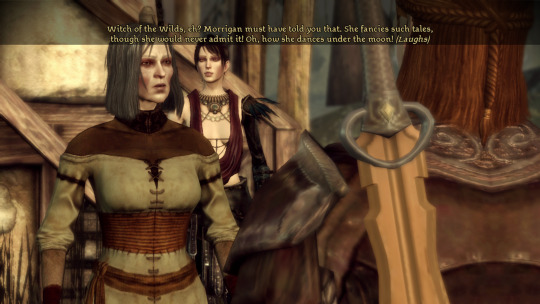
According to Morrigan's mother sharing embarrassing stories about her, Morrigan likes to go out and do witchy moon dancing for no other reason than to be doing witchy moon dancing. She's just. She knows what they are and she's all-in on the bit.
Morrigan loves the Witch of the Wilds aesthetic. She plays up her own spookiness on purpose. T'is probably why she talks like that when no one else in Thedas does.
And why she has so much fun teasing Alistair about his uptight Templar shtick.
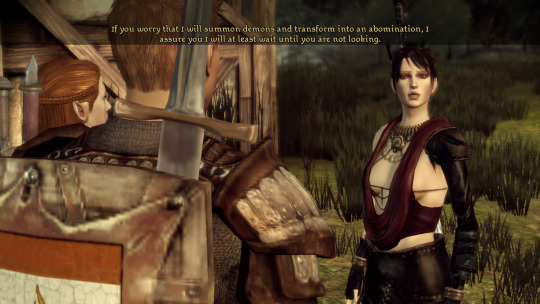
Morrigan is a vibe. On purpose.
We only meet them briefly before the Battle of Ostagar but they're here to show us the way out at the end. It's Flemeth who makes moving against Loghain possible by saving two Wardens who would have perished with the rest at Ostagar.
Flemeth is in complete control of this situation. She feigns ignorance, of course.
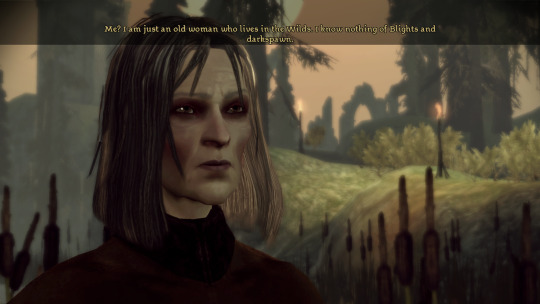
I mean, you and Fen'harel literally created the Blight but go off.
But, under the veil of obviously fake innocence, it's Flemeth who gently coaxes Alistair into devising a plan he didn't even know he had in the back of his mind.

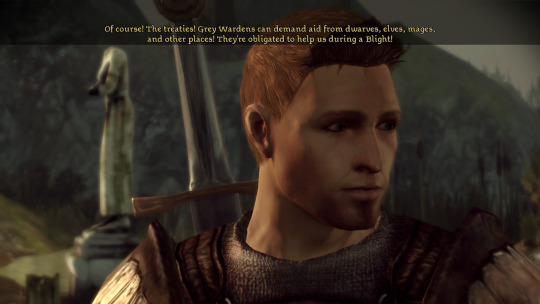
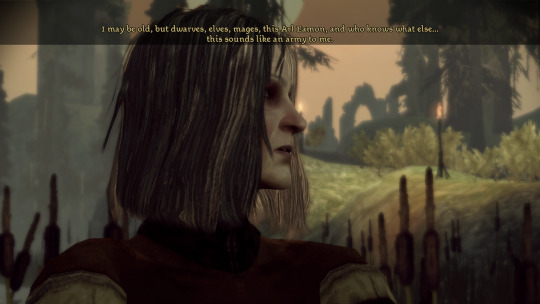
Mythal is putting her talon on the scale to move against June. Through Alistair and the Warden, she's setting the events in motion that will - if all goes to plan - release and reincarnate June's soul from his avatar Urthemiel.
Even if Morrigan can't quite appreciate the machinations that Flemeth has in motion, and is left floundering to try and keep up.
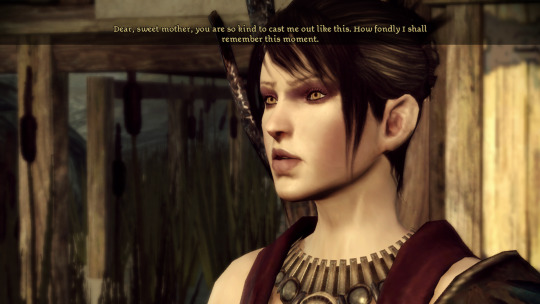
But despite her plans, Flemeth also has a great deal of hostility towards Thedas. She speaks cryptically about her past, but sufficient knowledge of her history can make sense of her words.
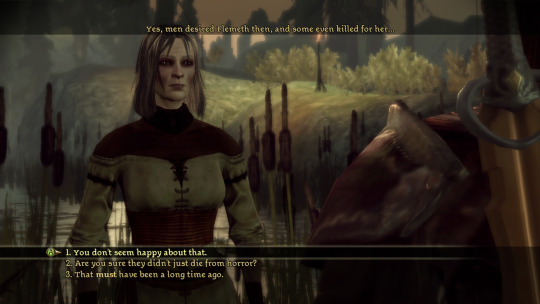
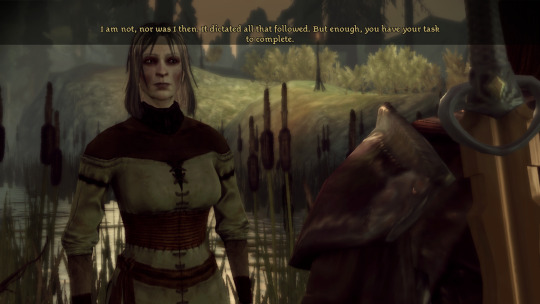
There are many stories about the human woman named Flemeth but the recurring elements are similar. Flemeth loved one man named Osen and was jealously coveted by another named Conobar, who murdered Osen to take Flemeth as his own. In desperation, Flemeth sought aid from spirits and became possessed.
What none of the tales know, of course, is that it was the Evanuris Mythal who came to her then. Neither spirit nor demon but a murdered elven goddess whose fractured spirit was left adrift..
But her resentment here of men who've killed for her is probably about Conobar.
This, on the other hand?
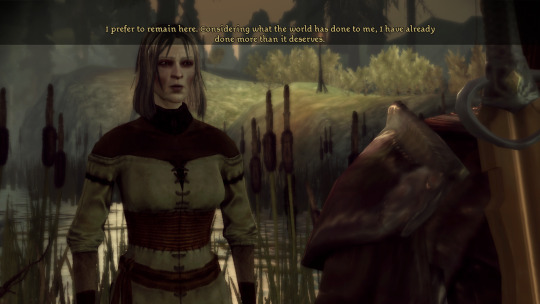
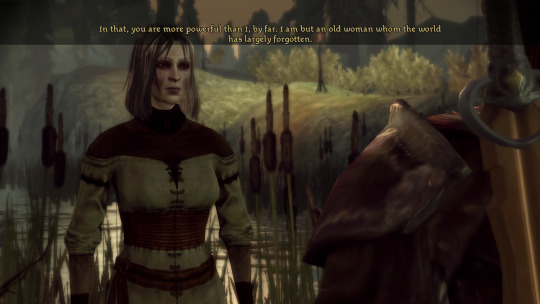
Is most certainly Mythal reminiscing about her betrayal and murder by the Evanuris, thousands of years ago in a history that the Tevinter Imperium burned to the ground.
Mythal, Flemeth, and Morrigan are key figures in the mythology and world of Thedas. And it's right here, in the aftermath of Ostagar, where they step out of the woods to shape the fate of the continent.
5 notes
·
View notes
Text
So, here are my thoughts on Now and Then
Can you believe we just got a Beatles song??? because I'm still trying to wrap my head around it. Ever since last week my expectations of this song were high -I mean it is them either way-, but this was way more incredible than i could have expected.
It is them. I know it sounds stupid to say it, but it feels like them. It's been over 50 years since the four of them made music together and yet this brings me back to them at their prime, with John bringing the lyrics and the soft voice, Paul the musicality and the experimentation, George the wonderful guitar and Ringo always knowing how to adjust perfectly to the rhythm. It's them being them, which might not be a cause of surprise if it weren't for the fact two of them are no longer with us. The fact they managed to pull this off out of pure love and respect for one another, for their legacy as a group, as the biggest of all time, is mind-blowing to me.
I'm amazed at how Paul wanted it to be mostly a John song, and abid to that with so much respect. The fact he only sings to complement John's voice, to add depth and to bring us back to what it felt like to listen to both of them, I love it so much. I am also very much aware of the fact this is John in his 30 something singing it with Paul in his eighties, and it shows: their voices together sound like always but sound like never. You can feel that time has passed for Paul and I love it because it is the essence of now and then.
The backing vocals, the fact they used vocals from the four of them is everything to me. The string arrangements give us the sound of the Beatles in such a unique and wonderful way, you can't help but feel this belonged to a space reserved somewhere between Eleanor Rigby and Because, and it is perfectly placed right there. You can tell everyone involved on it loves and knows the Beatles completely, which is no surprise considering Macca and Giles were the geniuses behind it.
I do have one tiny comment: the production feels very 2023-ish, which is not bad, it just feels a bit too modern, takes me out a bit from the 1960s rhythm that made me fall in love with them in the first place, but I understand times have changed and this also has to sound contemporary, is what they would have loved. I'm just old-fashioned.
I feel John. I feel Paul. I feel George. I feel Ringo. Everything that made them them is present within those four minutes. Everything, including John and Paul's endless intense, complicated and absolutely beautiful love for one another.
This is the most precious and perfect gift and I can't thank Paul and Ringo enough for giving us the chance to live one last release. Never thought I would live to experience with the world a new Beatle song, and I feel it like the biggest treasure.
They remain my everything. And I can't wait for the music video.
Oh, and the fact it's done and Love Me Do starts right after. My heart can't take it.
Anyway, so many things to say, so many things I love. Let me know what you thought!!!
#now and then#the beatles#john lennon#paul mccartney#george harrison#ringo starr#thank you for being my entire life dear fab four#i love you forever#thank you for saving me#anyway#i have so many feelings
26 notes
·
View notes
Text
The AKOM Holiday Shopping Guide!
Here are some items we enjoyed this year, great choices for yourself or that Special Beatle Person in your life.
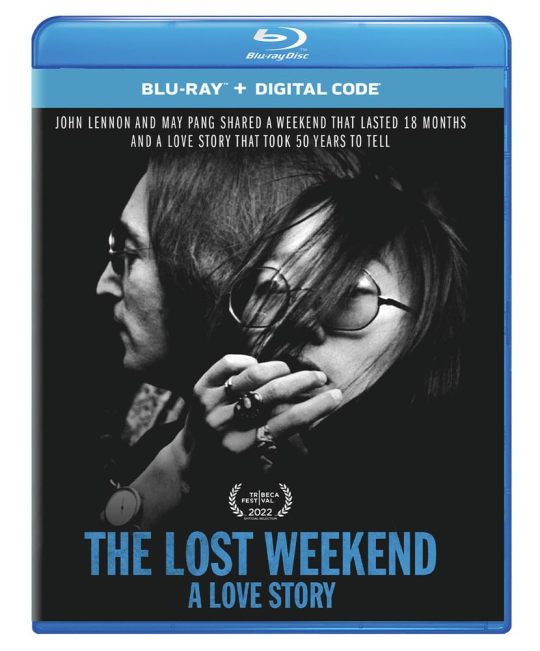
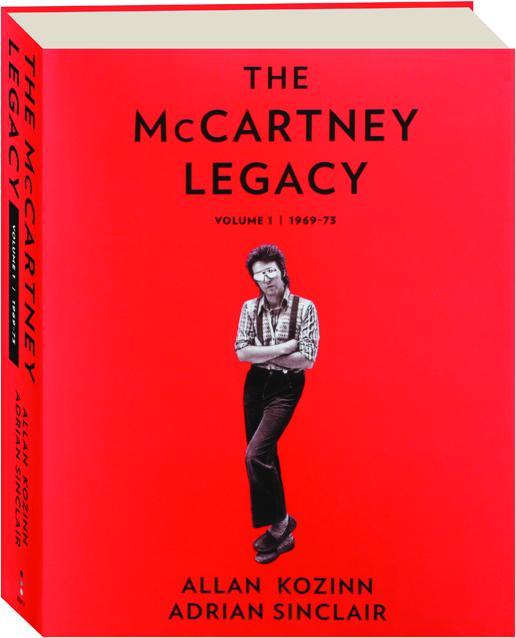
The Lost Weekend A Love Story (DVD, Blu-Ray, Streaming) 🥤 The McCartney Legacy by Allan Kozinn and Adrian Sinclair (Hardback and audio book!) 🐏
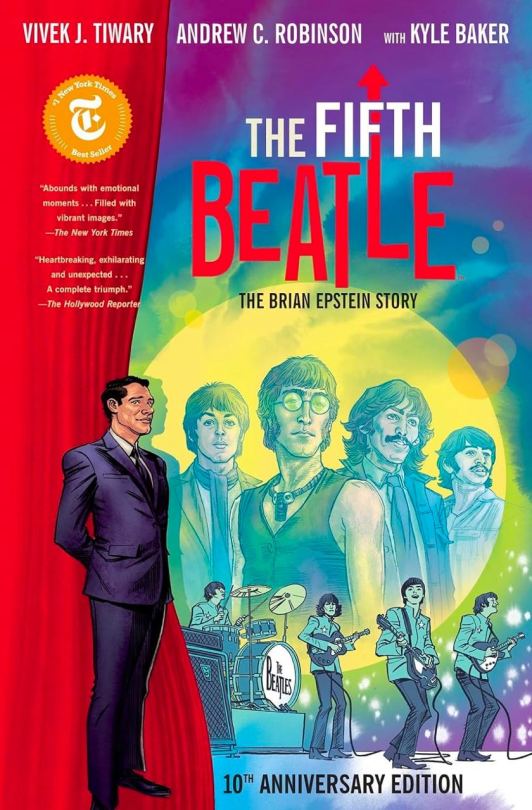
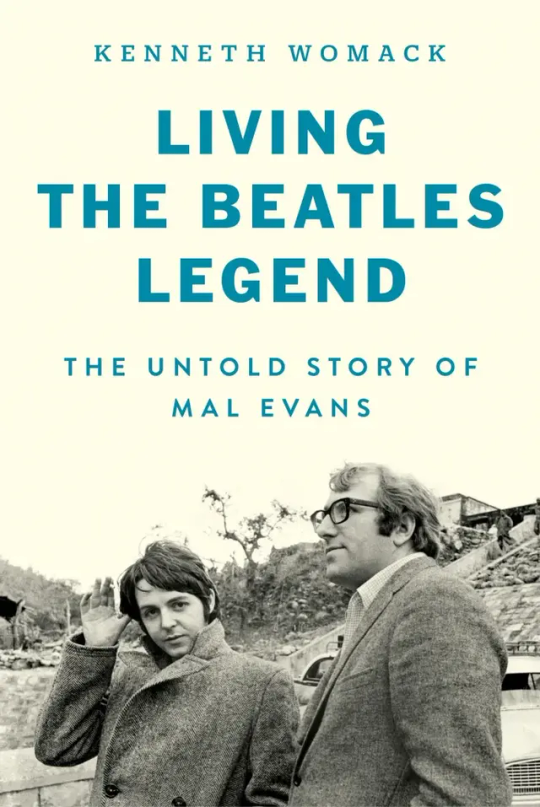
The Fifth Beatle (10th Anniversary edition) by Vivek Tiwary 🍏 Living the Beatles Legend: The Untold Story of Mal Evans by Kenneth Womack ⏰
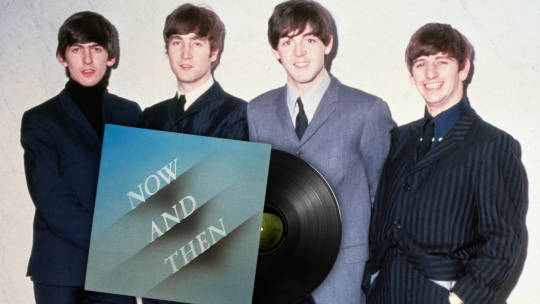
Now and Then, new Beatles single!! 📀
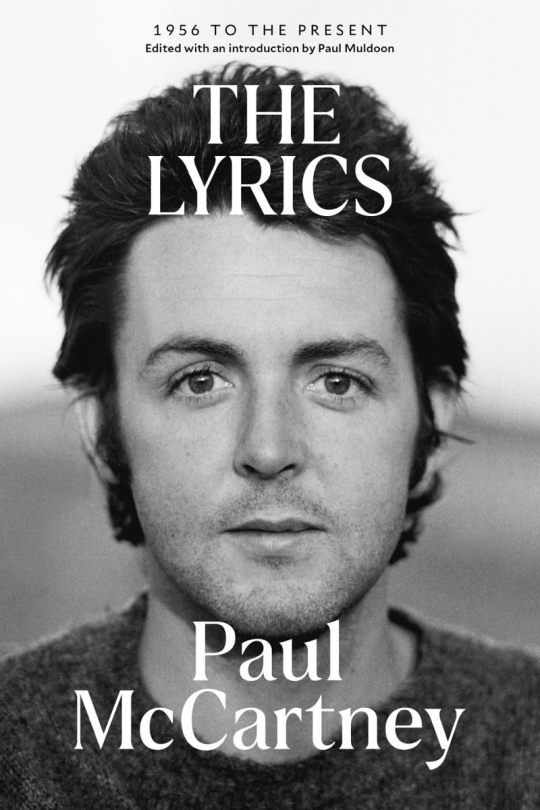
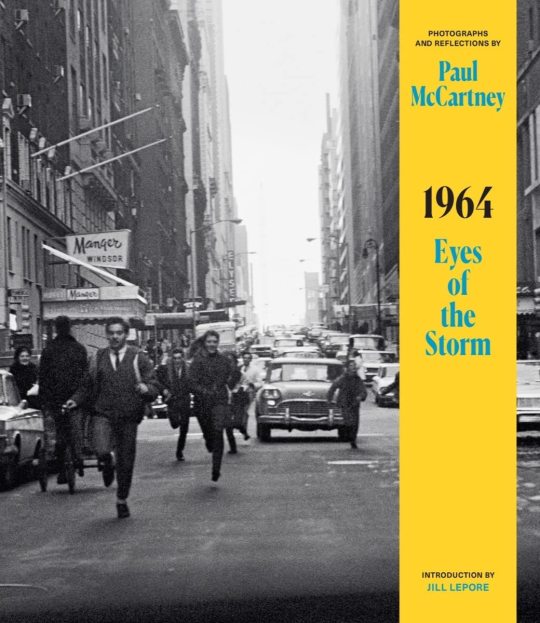
The Lyrics: 1956 to Present by Paul McCartney and Paul Muldoon (now in Paperback) 🎁 Eyes of the Storm by Paul McCartney 📸
Related AKOM podcasts: Reclaimed Weekend AKOM Talks w/ May Pang Frankensongs! AKOM Talks w/ Adrian Sinclair and Allan Kozinn The Fifth Beatle AKOM Talks w/ Vivek Tiwary The Mal Evans Story AKOM Talks w/ Ken Womack Eleanor Rigby: (The Lyrics podcast) Now and Then Reactions (IamtheEggpod)
#AKOM#recs#we aren't getting kickbacks#LOL#just thought we'd share our recs#another kind of mind#beatles
39 notes
·
View notes
Text


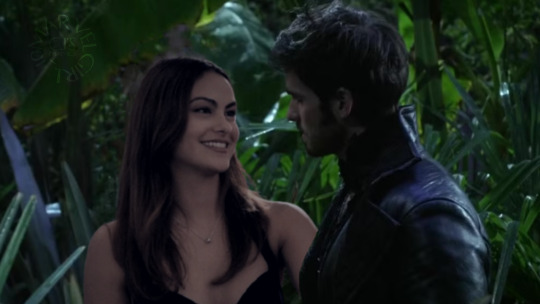

Manips for AthenaPersephone9 Series: The Infernal Chronicles on Wattpad Faceclaims: Camila Mendes, Colin O'Donoghue, Sean Maguire, Lola Flanery, Agnes Bruckner, Ginnifer Goodwin, Jennifer Morrison, Lana Parrilla, & Josh Dallas
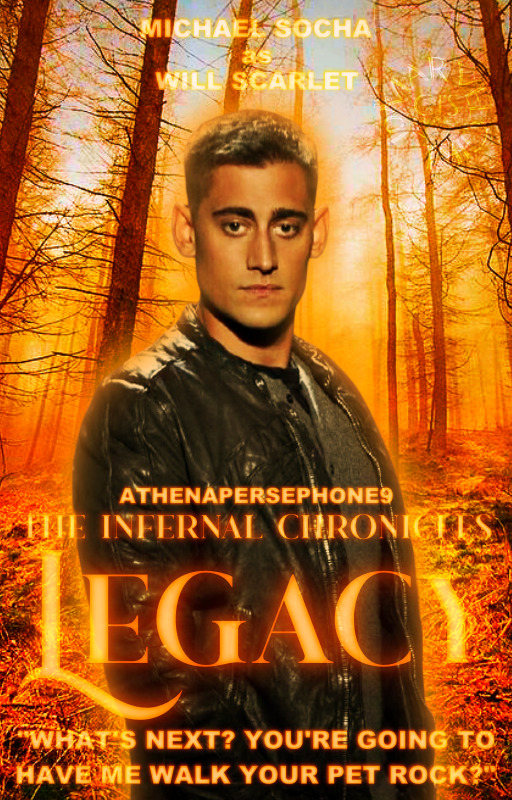
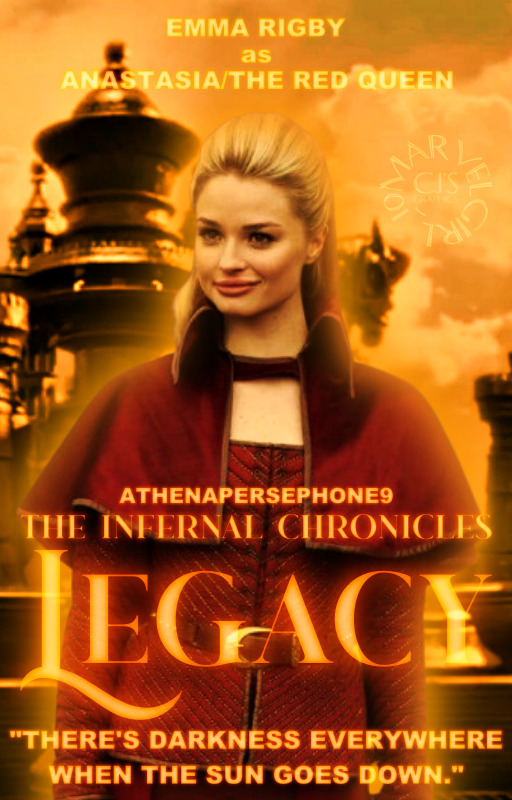
Posters for AthenaPersephone9 Book: Legacy on Wattpad Faceclaims: Michael Socha & Emma Rigby
2 notes
·
View notes
Text
WEEK FOUR LINEUP
Some minor changes this week, we have officially retired the SEE RESULTS option on the polls, down to five options. I probably won't be adding any new options unless there's a very good reason or high demand, so I'm sorry to the people who have asked for a "I know them and I love them with all my heart, positive cannot contain the love I have for them" option. With that being said, here is this week's lineup!
Mimi - Your Imaginary Friend
Tsubasa Arihara - Cinderella Nine
Tablet - Commodity Clash
Fox Alistair - RWBY
Alan B'Stard - The New Statesman
Sportacus - LazyTown
Tougou Mimori - Yuuki Yuuna is a Hero & Washio Sumi is a Hero
Rottytops - Shantae
Naomasa Tsukauchi - Boku no Hero Academia
Hagumi Hanamoto - Honey and Clover
Bellringer - Toontown Corporate Clash
Tarlach - Mabinogi
Ata Ibusuki - Binan Koukou Chikyuu Boueibu Happy Kiss
J - Heat Guy J
Mami Tomoe - Madoka Magica
Rocket Raccoon - Marvel Cinematic Universe
Princess Elle - Hirogaru Sky Precure
Phèdre nó Delaunay - Kushiel's Legacy series
Rex Mohs - Scott the Woz
Eileen Roberts - Regular Show
Waluigi - Super Mario
Rick - Denpa Men
Great Sage - Miitopia
Sidon - Legend of Zelda
John F. Kennedy - Clone High
Greg Heffley - Diary of a Wimpy Kid
Martin - Wii Sports
Yellow Face - Battle for Dream Island
Eraser - Battle for Dream Island
9-Volt - WarioWare
Luigi - Super Mario
Milo Murphy - Milo Murphy's Law
Rigby - Regular Show
Holidog - Holiday World
Jerry Attricks - Scott the Woz
Jeb Jab - Scott the Woz
Peter Griffin - Family Guy
Baljeet Tjinder - Phineas and Ferb
Gary - Regular Show
Skelly - I Spy Spooky Mansion
Max Schnell - Cars 2
Charley - Incredibox
10th Doctor - Doctor Who
Mii Brawler - Super Smash Bros
Miles Morales - Into and Across the Spiderverse
Party Phil - Wii Party
Lego Joker - Lego Batman
Knife - Inanimate Insanity
Fusk and Vorte - Hitmen for Destiny
Chaika Trabant - Hitsugi no Chaika
Jesse Pinkman - Breaking Bad
Agent - Penguinronpa
Squelch - Denpa Men
Muscle Man - Regular Show
Fuuta Kajiyama - MILGRAM
Jonathan Phaedrus / Prof - The Reckoners
David Charleston - The Reckoners
Spensa - Skyward
M-Bot - Skyward
Chet Starfinder - Skyward
Sirius Gibson - Witch’s Heart
Guy Montag - Fahrenheit 451
Zachary Zatara - DC Comics
Kento - Payday 2
The Shapeshifter - The Odd Squad
Akane Kurashiki - Zero Escape Trilogy
Letitia "Letty" Price - Babel
The Last Son of Alcatraz - The Monument Mythos
Lily - Duolingo
Ohio - The United States of America
Myne - Ascendance of a Bookworm
Rani - Disney Fairies
Agrael/Raelag - Heroes of Might and Magic
Donna - RErideD: Tokigoe no Derrida
Kasane Teto - Vocaloid
Martin the Warrior - Redwall
Colombo - Colombo
Sonny Wortzik - Dog Day Afternoon
Butch Cassidy - Butch Cassidy and the Sundance kid
Blondie - The Good The Bad and The Ugly
Prior Walter - Angels in America
Dark - Nowhere
Reona West - PriPara
Shax Lied - Mairimashita! Iruma-Kun
Villager - Minecraft
Wahanly Shume - Tenchi Muyo! War on Geminar
Qifrey - Witch Hat Atelier
Marvin - In Trousers
Mr. Bungee - A New Brain
Mayor Mingus - Dialtown
KAITO - Vocaloid
Almond - Postknight 2
Serial Designation V - Murder Drones
Flint - Postknight 2
Magnolia - Postknight 2
Nobara Kugisaki - Jujutsu Kaisen
Snufkin - The Moomins
Ikabod Kee - The Upturned
The Professor - Hailey's On It!
Chimumu - Waccha PriMagi
Mia Taylor - Love Live
30 notes
·
View notes
Text
The Other Playlist™
I was recently asked to make a young justice playlist so here it is!
@automaticsoulharmony it’s for you :)!
The young justice playlist is under the cut with explanations for each song
Tim
Ur gonna wish u believed me (start of brucequest)
Yes I’m a mess (I could see him deleting his identity)
Karma (AJR) (depressed man)
Mastermind (smart Timmy)
Don’t blame me (all his action with the loa)
Fool (him with the Wayne’s)
Wow, I’m not crazy (him when he meets the bats (he is crazy))
Humpty Dumpty (he’s a depressed lil guy)
Good 4 u (to dick about Damian)
Pretender (Acoustic) (Jason canonically calls him pretender I had to)
Mister Cellophane (everyone forgets about him)
Come hang out (he’s a workaholic)
Let the games begin (Tim enjoys power)
Heart of stone (depressionnn)
brutal (it’s just Tim coded)
Deja vu (to dick about Damian)
Every breath you take (stalker)
The sound of silence (he is so fucking depressed)
Go the distance (start of robin training and brucequest)
Viva La Vida (Tim coming back to Gotham)
Bart:
What ifs (him going to past)
2085 (he’s from the future)
Bones (him running)
Everything has changed (him coming back to life)
When will my life begin (him in vr)
We didn’t start the fire (he is from the future)
Go the distance (him going back in time)
Iron man (time travel)
How far I’ll go (look it’s easy to find Disney songs about going back in time)
For the first time in forever (him meeting actual humans after being raised in vr)
Adventure is out there (very adhd coded song very adhd coded character)
Into the unknown (going back in time)
Dead! (he died)
The nights (it gives me his vibes)
Blackbird (finally being in the real world)
Record player (he’s from the future so it would make sense for him to find 2014 old)
Over the rainbow (going to the real world)
Wow, I’m not crazy (meeting the rest of YJ)
The DJ is Crying for Help (him wondering what to do after becoming an adult)
Centuries (from the future so he knows they will be remembered for centuries)
Kon
Father of mine (Clark sucks)
Dead! (he died)
Teenagers (it gives me his vibes)
All you wanna do (he was canonically taken advantage of by several women immediately after being “born”)
Oops! I did it again (player)
Too late (him maturing)
Used to be young (him after the playboy years are over)
Cat’s in the cradle (Clark still sucks)
You’re on your own, kid (horrible father)
When will my life begin (being in CADMUS and wondering when he can leave)
What else can I do (discovering his powers)
Pity party (he was canonically forgotten by everyone he loves after flashpoint)
Rip (by bladee) (I’m still focusing on the being forgotten thing)
Drift away (talking about the other superboy who came to be while he was trapped in another dimension)
Pretty fly (for a white guy) (he’s a player)
Uptown girl (Cassie!)
Rät (finding out CADMUS is evil)
Back to life (I think the name explains it)
Sober up (talking to YJ)
Shake it off (him responding to insults he gets)
Cassie
Just a girl (it’s hard being a female superhero)
Me too (badass woman)
Clara Bow (how it feels being a legacy sidekick)
Thunder (she’s Zeus’s kid)
Emotionless (good Charlotte) (Zeus is not a good father)
Brutal (her Bart and Kon’s deaths meltdown)
Cat’s in the cradle (I really hate Zeus)
Toxic (her about Kon)
I can do it with a broken heart (having to continue being a superhero even though her friends are dead)
How far I’ll go (her first becoming a superhero)
Last kiss (Kon’s death)
She used to be mine (her thinking back to what she was before she became a superhero)
My heart will go on (Kon’s death)
Eleanor rigby (her being alone after everyone died and she betrayed Tim)
Womanizer (Conner before they started dating)
Devil town (it gives me YJ vibes)
Yesterday (missing when things were simple)
No scrubs (not liking Conner before they started dating)
Two birds (her and Tim being the last ones left and her staying on the wire)
Sober up (her and Tim’s mistaken dating after everyone died)
I hope you like this new playlist!
3 notes
·
View notes
Text
SPEAKING of playlist analysis! Here is my Meta Knight playlist, my favoritest playlist, my pride and joy-
Plus all of the explanations and meanings and stuff under the cut, in case you wanna go in blind first ouo!!
This Will Be The Day: This is Meta Knight joining the GSA and meeting Jecra and Garlude and stuff! He's young and reckless and doesn't yet realize just how serious and dire the war is- So this song is a pure representation of Meta’s current outlook! This is an adventure, a challenge, a revolution, an epic anime fight scene just waiting to happen! And the mention of fairytales and legends refers to Arthur and the knights (Falspar, Dragato, and Nonsurat) and how Meta idolizes them!
Eleanor Rigby (feat. Dream Jumpscare): OHOHOHOHO THIS ONE- And here the bright outlook is shattered as the reality of war sets in!! This one has the most animatic ideas bouncing around- Basically Jecra’s been missing for weeks but he comes back possessed, ambushing a GSA camp in the middle of the night and Meta’s forced to kill him-
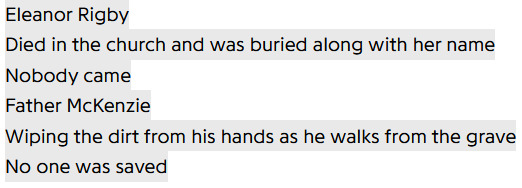
AAAAAUGHH THESE LINES THIS IS JECRA AND META KNIGHT IT’S LITERALLY THEM- THE GSA NEVER HELD A FUNERAL FOR JECRA BC HE WAS POSSESSED AND THERE WAS THIS UNSPOKEN WARINESS ABOUT IT- SO META HAD TO DIG HIS GRAVE AND OUGHHHHH AGONIES
And that part at the end where the music slowly builds up is Meta alone on a rocky ledge (the whole thing takes place in like a mesa desert) looking through a journal with photos of him and Jecra- Tears fall onto the pages and it just cuts to him with his mask off just crying as the sun rises over the horizon-
Experience: The fall of the GSA. It becomes more and more obvious that this is a fight they just can’t win. Meta’s forced to watch as ships crash and troops are obliterated around him. Just utter destruction as the few survivors left are scattered across the galaxy. It’s over… What do we do now?
Hush: The start of Meta’s crew, and maybe also his plans to take over Dreamland? Super intimidating, almost secret society vibes as the group grows and they begin construction of the Halberd. This one reminds me of Smash Bros Meta Knight’s almost regal aesthetic with the frilled cape and the detailed armor- I imagine the ending is the crew taking in a young Sailor Dee, like they’re trying to be comforting but it just comes off as menacing lol-
Settle It With a Swordfight: Tonal whiplash time! The other side of Meta's crew and a representation of Revenge of Meta Knight!! Note the more energetic electronic vibe and the guitar, as a callback to the first song and representing Meta’s readiness for a challenge!
Take Off: Meta learning to Chill Out after Revenge of MK, just being with his crew bc the Knightmares are a FAMILY and they LIVE ON THE HALBERD together and they do KARAOKE ON FRIDAYS
Awoken: META KNIGHT IN PLANET ROBOBOT- Both the effects of getting cyborg-ified and all of the guilt and angst involved, and breaking out of it through sheer willpower and Kirby's help! It's very electronic but there's no guitar, like trying to emulate Meta Knight's power but it's noticeably forced and artificial
Pain: OK I KNOW THIS IS LIKE. THE EDGY SONG EVER. But the way I saw it, it represents Meta Knight's will to fight and struggle and improve and keep going and live! There's the full on heavy guitar this time, just the very essence of those burning feelings!! I imagine the "take my hand" parts are him in the New World saving a Waddle Dee from an abandoned building full of beasts
Sword of the Surviving Guardian: Ok this theme was just too much of a bop not to include- But it also shows just how far Meta Knight’s come! As a warrior, as a friend, as a legend. This is a testament to his growth and a toast to his future!
Legends Never Die: OK I ALWAYS IMAGINE THIS SONG IN 3 PARTS FOR EACH CHORUS AND EACH GENERATION; Arthur and his knights (plus Galacta Knight), Meta Knight, and Kirby with the Ultra Sword- OUGHHH it’s so cool and gives me chills every time- Legacies written in the stars and the immortal call of heroism, to protect and persevere and stand up for what’s right
AND THAT'S IT :D The autism was STRONG when I made this as you can probably tell lmao- But for real, I'm extremely proud of this! It tells Meta Knight's story through the music, every song plays a role, I even took the instruments into account, it's great ouo!!
#also yes i know there's a dsmp animatic and a fansong in there- i made this playlist a long while ago akdhfksldf#kirby#meta knight#character playlist#my nonsense#losing it over songs tag <3
18 notes
·
View notes
Text
Watching a playthrough of Battle Network 1 (I'm gonna start with 2 once I have the free time to dig into Legacy Collection b/c I've heard 1's gameplay is janky) and a few thoughts so far:
That's so goofy that Dr. Froid's son is a total rando in the game but a major secondary character in the anime
I love how Chaud tells Lan his name and then later has the nerve to be like "Who are you and how do you know my name" like gee Idk it's not like you said it in front of him or anything, Eugene
I thought "Load Chaud" was just a one-time misspelling, does Protoman really call him that the entire game???
Wow Ms. Yuri is really different, I kinda prefer what the anime does with her even tho I haven't gotten that far
I BURST OUT LAUGHING B/C I WASN'T EXPECTING THE CARS TO JUST EXPLODE AND DISAPPEAR WHEN THEY CRASH INTO EACH OTHER THAT'S SOME REGULAR SHOW SHIT (I can hear Benson yelling at Mordecai and Rigby to delete ColorMan and stop the traffic accidents or they're fired)
#mmbn1#<- Idk if I'm gonna keep posting as I go or not so just in case this is for blacklisting if you don't want your dash overloaded with this
0 notes
Photo


Broke into her dad’s room to use his chess table
24 notes
·
View notes
Photo
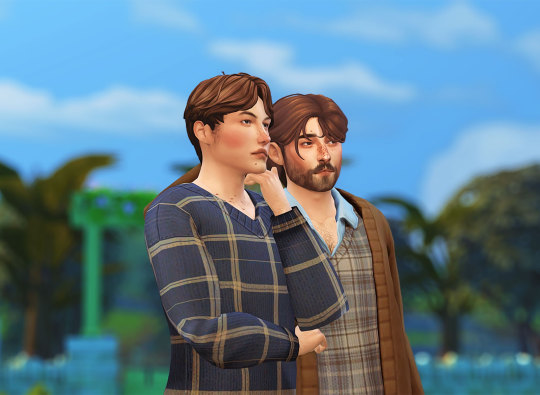
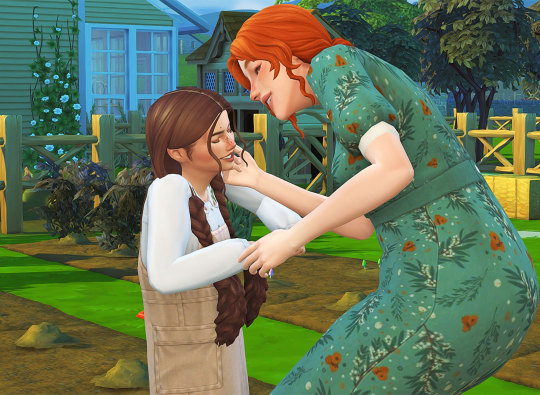
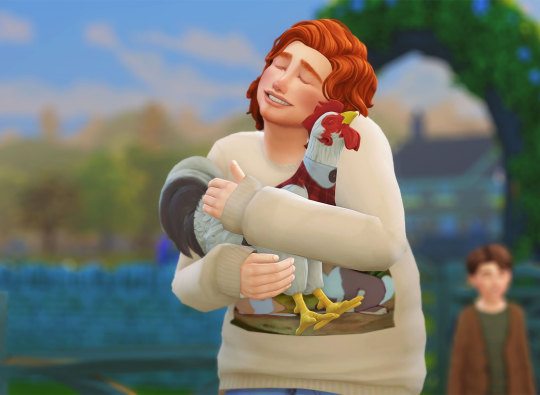
a day in the life of the potts family 🤍
#bird tw#ts4#ts4 gameplay#*potts legacy#*potts:one#*beatrice#*rhett#*bennett#*rigby#*landon#*inez#rhett and bennett are twins lol#i really miss this family so i was so happy to play them again but....#im going to take a step back from them for a bit bc i have no time!!!!!!!!#these next two months are the busiest for me so...see you in 2022 potts fam!!#thats so weird thats a real year
43 notes
·
View notes
Photo
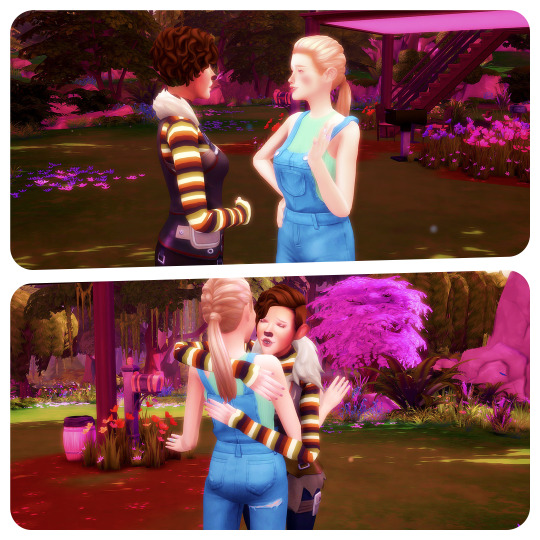

A high pitched voice broke Everly out of her reverie.
“You! You there! Are you a human? Ohmygosh, a human!!” The voice could only be described as chittery. Much like a squirrel would sound like if it could talk. Fast and high and cute and probably annoying if around it all day.
“Oh hello, I’m Everly--” but before she could finish, she felt arms pulled tight around her.
“I just knew something good would happen today! I felt the excitement in the air. I told Eugene, but he didn’t believe me, since he never does, but boy oh boy, is he going to feel foolish now!” the squirrel-voiced being continued, still not letting go of Everly.
before / beginning / next
#ts4#ts4 challenge#ts4 legacy#ts4 legacy challenge#ts4 gameplay#ts4 story#dpchallenge#dpgen1#everly#rigby
41 notes
·
View notes
Text
Paul McCartney
The riddle of the sources for Paul McCartney’s musical genius actually poses a greater problem than in the case of John Lennon. While Lennon had a manifest flair for exposing himself and his own contradictions, Paul has a gift for concealment and a desire to lend a controlled appearance to the tensions in his life. This has perennially earned him a reputation as smooth diplomat and skilled PR man. But such appearances are partially deceptive and they collide forcibly with the facts. Paul is no self-effacing second stringer and he did more than “carry that weight” in their partnership. The point is that Paul’s talents provided the ideal, complementary foil to John’s, even when they were working apart. Not only did they learn their composer’s trade as taskmaster to the other from 1957 onwards, but they continued to influence and rival each other throughout the Beatle years, and even after the break-up when their songs sometimes became open letters of mutual recrimination. Indeed, relatively speaking, the credit for the absolute Beatle smashes (such as “Yesterday,” “Hey Jude,” “Eleanor Rigby,” “Let It Be,” or “Michell” in their countless cover versions) belongs to Paul as the sole author or main collaborator (Schaffner 1978, 214).
My main purpose in reviewing the facts of Paul’s life is, again, not biographical in the conventional sense, but an attempt to come to grips with the mystery of his muse. It must be clear that the complementarity of his work with John corresponded to some kind of temperamental harmony as well. In what did this consist? What kind of a teenager had Paul become, at least for a moment in time, to allow “the perfect hand to find the perfect glove?” If John displayed a perverse structure (as I have argued), then what kind of structure did Paul’s personality obey to produce some kind of compatible fit? John’s posthumous canonization as the patron saint of the baby boom generation, as well, as the stormy 1988 controversy over John’s legacy and memory, have tended to obscure Paul’s specificity as a person. This not only retrospectively skews the genesis and development of the Beatles, it also prevents us from taking a deeper look into the second well out of which the group’s genius flowed.
The primary enigma about Paul is his much self-advertised “normalcy.” But normal people do not conquer the pop world twice over, as a Beatle in the 1960s, and with Wings in the 1970s. Nor do they go on to become the most successful songwriter in history and accumulate a fortune commonly estimated to be worth over $600 million. “In terms of sales of single records,” according to the Guinness Book of World Records (1986), “between 1962 and January 1, 1978, he wrote jointly or solo 42 songs which sold one million or more records” (Flippo 1988, x). Paul’s normalcy is a myth for public consumption, just as John’s various poses were. I believe the truth about any artistic genius is otherwise. In Lacanian terms, his upbringing and entire career proclaim the structure of obsessional neurosis, with the kicker that lyric effusion has been his strange salvation from the suffocating effects of this obsession. To vindicate such a thesis, we must now return to the events preceding his birth in Liverpool.
Kinship Structure Prior to 1942
James Paul McCartney was born in Walton Hospital at 107 Rice Lane on June 18, 1942, the first son of James McCartney and Mary Patricia (née Mohin). His father Jim (1902-1976) had been one of nine children born to Joseph and Florence McCartney. Old Joe McCartney worked as a tobacco cutter for the firm of Cope’s and had been born in Everton in 1866. His father before him was James McCartney II, a journeyman painter and plumber who hailed either from Liverpool or Ireland. His father in turn, also called James McCartney, had been an upholsterer, but his origins in Ireland remain obscure. Paul’s social background, therefore, belonged in that shadowy area of the British class structure between the working class and the lower middle class. It was his mother’s ambition and career as a health care professional that enabled the family to escape into the relative security of the middle class proper. But there was an emotional price to pay in the family structure for the material advantages accruing to this precocious dual-career couple.
“Mary’s money” became a dominant signifier in the McCartney family. Jim had gone to work at fourteen as a sample boy for the cotton firm of A. Hannay & Co. at the rate of six shillings a week. This was at a time (1916) when the Liverpool Cotton Exchange was still a major international force in the industry, and eventually Jim rose to the rank of salesman at the substantial salary of five pounds a week. This advance was unusual for one of his modest beginnings, and the promotion gave him a sense of pride, while it also rendered him a very eligible bachelor. He married Mary Mohin at a Catholic ceremony in Gill Moss, Liverpool on April 15, 1941. The war, however, was to bring a steady, but unavoidable decline in his fortunes.
In the first place, the outbreak of hostilities led to the closing of the Cotton Exchange, and Jim was too old for military service. So he was went to work at Napier’s aircraft factory as a lathe-turner. While this was a step down to manual labor, the patriotic work did form part of the war effort, and Jim also spent his nights as a fire warden trying to deal with the conflagrations caused by the stubborn Nazi bombing of the seaport. But by 1943, Jim was transferred again as an inspector for the Liverpool Corporation Cleansing Department. This positively demeaning temporary work required him to check on how well the city garbage crews were disposing of their smelly loads. It had no aura of patriotic service about it, and, worse still, the pay was poor. For one who had come so far, given his lowly background, this reversal was a source of shame. In consequence, Mother Mary resumed her job as a health visitor. Her pay was actually better than Jim’s, and this situation did not mend even when the Cotton Exchange resumed business after the war. The world financial picture had also permanently altered, so Jim rarely brought home more than six pounds a week, little more than his pre-war wage. The proud man had, therefore, to swallow the pain of knowing that his contribution to their weekly budget was the same as his wife’s and that she made their comfortable home possible.
While households with two incomes have become a norm in our present day, and relatively few husbands now forbid their wives to work outside the home for the sake of their own masculine pride, such households were rare in Britain in the mid-1940s. The prospect shook up popular perception of “natural” sexual roles. And the matter of perception is what is at stake for a consideration of the McCartney family. There can be no doubt that Jim loved his wife dearly, long after her death in 1956. But Paul was the apple of her eye. The facts behind this nexus give the clue to Paul’s obsessional structure.
Though not given to great maternal displays of affection and love, Mary was typical of many women in her assumption that – out there in the world – there must be “at least one real man” (Lacan 1973b; 1987). This essentially feminine, waiting, position recognizes that most men are not really “the one,” but hope springs eternal in the consolation that the Prince is somewhere and that she will eventually meet him. Doubtless, it may have seemed to her in 1941 that Jim was this “one.” But his declining status as a provider made her feel that he was inadequate. She esteemed him less after Paul’s birth in 1942. The message the mother henceforth gave her children in this family structure posited that the model of their father was not worth very much. They must, therefore, take the mother as model, a masculine feminine. In her desire to be an adequate provider and leader, Mary actually sent her son a message of guilt. The little boy accepted the proposition of Daddy’s inadequacy, and took the burden of his father’s assumed guilt (in his mother’s eyes) onto his own shoulders. To repay such an emotional debt, the obsessional son usually concretizes this around converting the debt into money that is owed or outstanding. Paul has regretted his notorious outburst on learning of his mother’s fatal illness, both then and since. But it illustrated the truth of the foregoing remarks: “What are we going to do without her money?” (Flippo 1988, 16).
For Lacan, the obsessional male is a subject who is overidentified with his mother and the feminine. The son must make up to his mother for the failures of a denigrated father/husband who let her down; for what he – in her estimation – did not give her. But while the son henceforth carries the burden of paying someone else’s debts, he feels angry about it. Such a feeling may add some new consistency to the lines Paul wrote for “Carry That Weight” on Side Two of the Abbey Road album, where the boy who is going to carry the weight for so long could literally be himself. The ringing echo of this childhood burden is what frames the obsessional’s characteristic life question: “Am I alive or dead?” Am I alive to the specific impulses of the here and now and free to respond to them? Or am I a slave being spoken by the dead letters of a remote infancy from the place of the Other (Freud’s anderer Schauplatz)? Much in Paul’s behavior towards his father over time makes better sense if we pursue such a line of argument. This can best be shown, oddly, in light of the signifier for horses in the McCartney and Mohin clans.
Horses made and wrecked the fortune of Mary’s father, Owen Mohin, an Irishman from Co. Monaghan, who had emigrated to Glasgow in 1892 and then to Liverpool in 1905. Mary was the second of three children, and her own mother, Mary Teresa Danher, died in childbirth in 1919. Owen then returned to Ireland with his family, but, after a failed attempt at farming, set himself up as a coal-merchant in Liverpool and prospered. Not only did he own five delivery carts, he used his rigs in the summer months for moving households as well. Things went so well for him that, at one point, he owned four race horses. But gambling proved an irresistible addiction to him and he eventually lost everything. It was while on a trip to Ireland in 1921 to buy horses that he met Rose, his second wife. When he returned to Liverpool with his new bride, it transpired that Rose and his twelve-year-old Mary could not endure each other, so Mary moved away to live with her mother’s kinfolk and became a trainee nurse at Alder Hey Hospital.
It must have been with some dread that Mary contemplated her husband Jim’s fondness for betting on horses. It was one of few weaknesses he displayed in a disciplined and honest nature. Her own father had worked himself up from obscurity, grown comfortable, and then slid back into poverty. In what must have been a milder, but gruelling repetition of history, her husband’s career described the same trajectory. But, intriguingly in the light of our comments above, Jim’s major setback with horses was linked to an attempt to make up to his own mother, Florrie McCartney, for what she had never in her own life received from her husband Joe: a real summer vacation. Jim’s plan was to send her to Devon for several days. The gamble failed, however, and his bookies reported the debts to his employer, Mr. Hannay. In view of the circumstances, his employer generously picked up the tab and also advanced the money for Florrie’s holiday. But their arrangement was that the debts be repaid on a strict schedule over one year. Thereafter, Jim walked the five miles to work every day to economize on bus fares, a kind of protracted penance for his ill-conceived trust in the racetrack to assuage his mother’s sorrows.
Now Paul’s career can be construed in one fashion as a massive attempt to make good on his father’s debts. According to Pete Best, Paul was always the stingiest of the Beatles, and he became by far the wealthiest. But when Paul had just turned the corner financially, he made a strange gesture to his father. At the reception for A Hard Day’s Night held at the Dorchester Hotel on July 6, 1964, Paul presented his father with a gift for his sixty-second birthday (which occurred on the following day). It was a painting of a horse. Jim felt confused, thinking: “It’s very nice, but couldn’t he have done a bit better than that?” Then Paul revealed that the painting was of Drake’s Drum, a racehorse that he had bought for him at a cost of £1,050. Paul said: “My father likes a flutter [bet]. He’s one of the world’s greatest armchair punters” (Salewicz 1986a, 167-68) An “armchair punter” is one who talks, but does not act. Paul was also indirectly saying to him: “Here is your weakness. This is the symbol of your debts, which I am unconsciously bound to pay.”
Finally, it is worth noting that Paul himself has become an accomplished horseman. On his Waterfalls estate outside Rye in Sussex, Paul keeps several horses amidst his huge menagerie. There is a photograph of him at the end of Gambaccini’s memoir, waving his left arm astride a handsome nag, fetlock-deep in a stream (1983, 112). His stable forms part of his daily ritual. “Like a typical working-class Northern man, Paul expects Linda to rise early and cook his breakfast and get the kids off to school while Paul feeds and waters and exercises his horses before traveling up to London by train or car” (Salewicz 1986a, 247). Though riding and wealth commonly reflect each other in England, Paul’s ownership of horses obviously continues a long-established pattern in the weave of the McCartney-Mohin family myth. Even the betting mentality of the British lower class shows an obsession with getting into the money associated with the upper class via horses.
As regards Paul’s ambiguity towards his father, it can be seen again in the gift he made to Jim of a five-roomed detached house called Rembrandt in Baskervyle Road, Heswall in Cheshire. He also invited his father to quit his low-paying job as a cotton salesman, which Jim gladly did. In subsequent years, however, according to the arguably biased account of Angela, Jim’s second wife, in a London Sun exposé, Jim was financially hard pressed to keep the house up. He urged Angela to say nothing, but to pretend that his crippling arthritis made it hard for him to climb stairs. Paul then bought the house back from his father, and the aging man moved into his final home, a bungalow in Heswall. Despite his ailing condition, however, when Angela and Jim visited Paul and Linda at their farm, they were obliged to sleep on mattresses on the garage floor. Conversely, when Paul and Linda visited them, they raided the freezer without paying for what they ate (despite a housekeeping allowance of only twenty pounds a week), while Linda had her groceries sent up by train from Fortnum and Mason’s in London (Flippo 1988, 343).
Angela doubtless tried to injure Paul and Linda out of spite by these revelations. But one might argue that they do not attest to planned cruelty, so much as to the unconscious power of the signifier for money in the McCartney family, even in the midst of abundance. It was this signifier in Paul’s Other that did the talking. The most stunning example of how much a wealthy couple can still feel poor, or unconsciously still at risk, came in a 1985 interview. Talking to Diane de Dubovay for Playgirl magazine, Paul remarked that: “My dad never told my mum how much he earned. Linda still doesn’t know [how much I earn]. You could never convince me that I had earned enough” (February 1985, 104). Then he fantasized his wealth might disappear in a left-wing coup: “I work, and a friend of mine explained to me that if there were a communist takeover they might take it all away.” At this, Linda panicked, and Paul reassured her: “Don’t worry Lin. I’ve checked it out. They can’t.” Linda, for her part, denied that Paul could be earning as many millions as reported, and added: “My philosophy about money is that as long as we have enough to live on, with a little extra in the bank, we don’t need any more” (Playgirl, February 1985, 104).
The Early Sources of Paul’s Creativity
Two key events in Paul’s early life turned him towards charming and entertaining strangers through the medium of music: the birth of his younger brother, Mike, in 1944 and the death of his mother in 1956. Peter Michael McCartney was born on January 7, 1944 in the same Walton Hospital ward where his elder brother had seen the light of day. Now while the concept of sibling rivalry has been fairly well defined in recent times, this version of the event was especially charged for little Paul. In the first place, the rival was a same-sex child – another male to compete for their mother’s fond gaze. Mary seems to have been careful of Mike’s welfare, sticking up for the underdog, but never relinquished the preference for her first-born son. Mike, for his part, formed an ineradicable bond with his mother, and his ever-fresh tears over his mother’s “passing” inform some of his autobiography’s most moving pages (M. McCartney 1984, 28). Mike resembled his mother physically, while Paul favored Jim. Mike grew taller and, if anything, more handsome than his angelic, “doe-eyed” elder sibling. The particular pique in the appearance of this rival for Paul, however, lay in the timing.
Lacan’s famous mirror-stage lasts from approximately six to eighteen months in early life. It is the period before the advent of coherent speech when the infant acquires the linings of a specular ego (moi). Attention is focused on the maternal figure who serves as an anchor and a nurturer. One consequence of the intervention of language at one and a half years is to teach the child limits and what Lacan called castration: an end to the illusion of omnipotence and his exclusive access to the mother. It is thus highly traumatic, one of the first, inevitable injuries of early maturation. Now, as chance would have it, Mike arrived on the scene at exactly this time: actually twenty days after the date Paul reached eighteen months.
So it is fair to say that Paul suffered the trauma of castration twice over. Not only was he dethroned from the place of privilege with his mother, as most small children are, but this place was instantly assumed by an infant who usurped the role of “king baby” (Freud) that had previously been Paul’s. Paul therefore attempted to turn in his own direction “those unexpected torrential floods of pure love that poured the way of the newly born child” (Salewicz 1986, 19). He learned the art of charm, how to win back by personable efforts and skill the status and affection that he had lost to his new rival. He acquired the knack, in the act of beginning to speak, of reaching out to friends and neighbors to regain the position suddenly denied him in the family’s enlarged structure. This skill has characterized Paul McCartney’s public demeanor throughout his career.
As is normal in sibling relationships, Paul also showed ambiguity towards his younger brother. He was protective of him in school, and came to his aid if he was bullied by older boys. On the other hand, his unconscious resentment of Michael sometimes took a terrifying turn. One afternoon, the boys found a can of gasoline in the garage at their Uncle Harry’s Huyton home. They bet each other that the gasoline would or would not burn up the wall behind the garage, and Paul bet Mike a bag of marbles that it would not. Having egged him on, Paul then let Mike climb onto the garage roof and set fire to the trail of gas. The flames were so fierce that Mike was trapped on the roof and could not climb down. A passing police constable saved the situation. On another occasion, Paul – as was his wont – picked Mike up by his ankles and swung him round. Paul “lost” his grip and Mike hit the concrete, losing his two baby eye teeth in the process.
A more serious accident that happened at Paul’s instigation took place at a Derbyshire scout camp in 1957. The scouts rigged up a pulley system for hauling logs up a cliff for camp fires. Paul then suggested to his brother that they see if Mike could be lowered down the cliff in the same manner. Paul then became worried at the speed of his descent and the scouts tried pulling on a rope to slow him down. They pulled the wrong one, and Mike plunged down the cliff, smashing into an oak tree and fracturing his left arm severely in three places. Mike then spent several weeks recuperating at the Sheffield Infirmary, where he was visited loyally by Paul every day. All three of these “accidents” involved a bungled performance (Freudian slips or Fehlleistungen), in which the “mistake” was the unconsciously intended action.
This is all to say that Mother Mary’s total attention mattered very much to Paul. Her death from breast cancer in 1956 was indisputably the most important event in Paul’s young life, since, in seeking solace for his grief, he turned to music and the guitar. Mike wrote much later on: “Mum’s death affected us more than we’ll ever know. Without knowing what a soul was, her death touched it, reaching right down to the bottom of my heart. I was twelve and Paul was just fourteen” (1984, 28). Mary had ignored severe pain symptoms and a breast tumor as simple signs of menopause as late as August of that year, and was in unspeakable agony before she would seek medical attention. By the time she was admitted to Liverpool’s Northern Hospital, the cancer had metastasized so completely that she died within hours, on October 31, after receiving the last rites of the Catholic Church. But this death was not a random event. In view of its undoubted centrality to Paul’s subsequent career, we should try to understand its aetiology within the family kinship structure. For one thing, it thrust Paul in contact with the Real of loss and made death a possible theme in songs he would write with the Beatles. More importantly still, the chain of causality in Mary’s death tells us a lot about the woman who was Paul’s mother.
That the breast was the “selected organ” for Mary Mohin – a vital part to which a signifier, the signifier for death, had become attached – might have been guessed at when she gave birth to Michael in 1944. After the delivery, she was readmitted to Walton Hospital with mastitis, an inflammation of the breast caused by infection. We do not know from existing printed sources which of the dozen or so varieties of mastitis afflicted her. Plasma cell mastitis, for example, is a condition characterized by tumor-like new growth of these cells, but the tumors are not malignant. By taking a long step backward and looking at her life as a while, however, it seems clear that nursing, the breast, and life and death were an intricately dependent nexus for her.
Some of Jacques Lacan’s followers, notably Jean Guir, have argued for a psychosomatic origin to cancer, and have found support for their theories in Lacan’s teaching. Specifically, a psychosomatic subject must have experienced a bitter separation in early life, repress rage and anger very strongly, live through another loss or separation in later years, unconsciously fail to marshall the immune defense system in the face of this new blow, and thus leave some vital organ defenseless against the presence of a suitable carcinogen. The disease then develops in the organ around which some identity theme, or life theme, has become unconsciously woven (Guir 1983, 61). Mary Mohin, as we know, lost her own mother as a little girl of ten. This was the “bitter loss” in early age which, significantly, occurred in childbirth. Her mother gave birth to Wilf, Mary, Agnes (who died at the age of two), Bill, and the baby who died with Mrs. Mohin in January, 1919. In other words, Mary’s mother died when she was nine months pregnant, and just prior to lactation.
At about thirteen, Mary Mohin left her own household because she resented her stepmother’s arrival, and chose to become, precisely, a “nurse.” Now this was a common career choice in England for single girls of Irish descent (it still is), but Mary’s choice was already heavily invested with symbolism. A nurse tried to save life. Moreover, it is only in English that the etymological crux on breast feeding and attending the sick exists. The terms in German (Krankenschwester) or French and Spanish (infirmière, enfermera) refer only to illness. Nurse is from the Latin nutrix, a woman who suckled or nourishes an infant, and the English term originally meant a wet-nurse specifically. It is hard not to connect the death of Mary’s mother, pregnant and preparing to “nurse” a new infant, and Mary’s rejection of a substitute mother in favor of “nursing” others.
Second, Mary trained hard and rose to the rank of hospital sister before her marriage. When the straitened financial situation in their home forced her to resume work, Mary turned to health visiting, but the office-like routine made it seem dull compared with nursing. Mary then decided to become, and this is crucial to the story, a district or domiciliary midwife. Her work on a housing estate obliged her to attend pregnant women before and after childbirth, but also to get up at all hours of the night to assist in the actual delivery. This was selfless and yeoman service for which the community praised her, but it placed Mary constantly in the vicarious position of saving her own mother and dead sibling from dying. The bout with mastitis in 1944 showed that a psychosomatic deterioration had afflicted one of her breasts already, and a cancerous lesion must have developed in the following decade. The key second loss was probably her sense of grief at seeing her husband go down in the world, seemingly repeating her own father’s shame and ruin. She then walked straight into the world of midwifery, whose signifying links were life, livelihood, and her own death by refusing to attend to her own pain.
Paul was, therefore, the son of a woman who repressed and denied her own pain, even when it shrieked through her body. She was a stoical, unsmiling woman (as all the extant photos make clear), whose exemplary nurture and domestic discipline made for a salubrious and comfortable home. Paul would rank her homemaking characteristics the test sine qua non in any prospective bride of his own, as we shall see. But, above all, she concealed her intimate feelings and sought to flee her demons in a gruelling regime of work. Denny Laine of Wings was probably closer to Paul than any other male friend throughout the 1970s, playing, talking and getting stoned with Paul countless times. But Laine reported: “[Paul] is the best person I have met in all my life at hiding his innermost feelings” (Flippo 1988, 361). Paul is in this his mother’s son.
But Paul was his father’s son when it came to his early exposure to music in the family. In the 1920s, Jim McCartney had been the leader of a semi-professional combo known as Jim Mac’s Jazz Band. He had a serviceable piano technique, and their repertoire was mostly ragtime and vaudeville. He also composed a number entitled “(Walking in the Park with) Eloise,” which Paul recorded pseudonymously with the “Country Hams” in 1974 (EMI 3977). Jim had taught himself chords and musical notation at the encouragement of his own father, Joe, who played a big tuba in the Territorial Army’s brass band, as well as in one sponsored by his tobacco firm at Cope’s. Old Joe, moreover, had a fine singing voice, such that during the 1920s their parlor, or sometimes the street outside, was full of communal music.
At first, Jim tried to encourage Paul to take up the trumpet. This did not suit Paul’s “deposed sibling” concept of being the focus of attention as the singer, however, and it was his mother’s death that drove Paul into an obsessive absorption with the guitar. It became his therapeutic salvation. Curiously though, despite the fact that Paul plays piano and drums with the normal fingering, he found the guitar awkward at first. Soon he realized that he was left-handed, and he restrung the instrument, holding the neck in his right hand and striking the strings with his left. This gave Paul a symmetrical look as a Beatle, his Hofner violin bass pointing in the opposite direction to John’s three-quarter size Rickenbacker. Since Paul’s left-handedness on guitar is the first of his few overt idiosyncrasies, we may wonder if it fills in our analytic picture in any way.
Many languages have strongly negative connotations for the left hand: sinister in Latin, gauche in French, “cack-handed” in English. The Spaniards actually borrowed the Basque word izquierda to avoid the Latin tradition. But these grim meanings are perhaps best grasped by looking at the etymologies for the right hand. The Western languages connect it with Law: Recht in German means both “right” and “law,” similarly French and Spanish (droit, derecho), Latin (rectus = correct, rectitude), or Greek (orthos = straight, right). Thus, arbitrarily from the biological point of view, the right hand symbolized the Law of the Name-of-the-Father and the left is its opposite, its sinister subversion or denigration. The bar sinister in heraldry, for example, refers to bastards born outside the law with respect to the Father’s Name.
Inasmuch as it was Paul’s obsessional desire to be what his father was not or did not become – a band-leader, a professional musician, a composer – he far outstripped him (Salinas Rosés 1988, 26-32). He did it by setting himself against him, by going against the “straight” model that the mother had underesteemed. He subverted his father by assuming the “left” stance to beat him at his own game. Paul may have imagined their antagonism was mutual, since he blurted out to Hunter Davies in 1981 (when both Jim and John were dead): “I realize now [John and I] never got to the bottom of each other’s souls. We didn’t know the truth. Some fathers turn out to hate their sons. You never know” (1985, 372). In the emotion-laden context, this apparent non sequitur jumps at one like a Freudian slip. As a boy, after being punished by his father for swimming in an off-limits lime pit, Paul sniffed to Mike that he was going to dig a big hole and fill it full or water and, then, take their Dad up in an airplane and push him out and into the big hole (Flippo 1988, 13). While Jim may have resented Mary’s fondness for Paul and her quiet disappointment with him, any perceived hatred of father for son and fantasized parricide belong to Paul, not to his father. Becoming a better musician than his father “the other way around” was a sublimation of these feelings.
At least as important here is the maternal component: the left-handed guitar gave Paul the emotional sustenance to struggle through the mourning period. But the instrument was also a musical stand-in for the lost love-object. It stood for the Real of the feminine support that was gone. The guitar said implicitly: “Mother’s left.” But this “left” could also be expressed in the holding of the instrument’s body on the left of Paul’s own body, a signifier which the English language readily supplies. So, in typically overdetermined fashion, Paul’s southpaw stance on bass is the living expression of the emotional coordinates by which he came to his favorite instrument.
The ”Psychomusical Matrimony” with John Lennon, 1957-1968
It is now time to look at the famous Lennon-McCartney partnership from Paul’s point of view. They met, as we know, on July 6, 1957 at Woolton fête, some eight months after Paul’s bereavement. Apart from the obvious technical admiration John felt towards the younger boy and Paul’s wonder at someone outrageous enough to go and form a skiffle group, the question arises for our argument: how would a rather typical obsessional find his soulmate in someone perverse? We have set out the various reasons why John felt drawn to Paul. What was happening emotionally on Paul’s side? How could the two desire structures dovetail?
Up to this time, Paul had been a hardworking and dutiful grammar-school boy. He was one of only four out of ninety pupils at his Joseph Williams elementary school to pass the notorious eleven-plus examination that got him into the Liverpool Institute. At age sixteen, he went on to pass seven subjects in the “O-level” GCE (the equivalent of the US high-school diploma, but awarded on the basis of nationwide competition), including Latin, Spanish and German. Considered capable of a career as a university professor by his teachers, he formed a dramatic contrast to the academic disaster that was John Lennon. For a disciplined “keenie” like Paul, therefore, John acted like a nuclear bomb. He gave Paul flagrant subversion and craziness, the excitement to dismantle conventions and find the courage to go with his creative desire. He shook up Paul’s assumed horizon of what was possible, injecting pain, mordant wit and searching wistfulness into Paul’s practiced optimism. Later on, John abolished all sense of harmonic and melodic rules in their compositional experiments together, because he knew few rules and cared little about any rules. John, in a word, gave the bourgeois Paul the major thing he lacked in his Other: a taste for risk.
Most of all, John’s outrageousness permitted Paul’s obsessional nature a kind of moral vacation. When you are inwardly bound to slave in the payment of another’s debts, to work in the alleviation of the (now dead) mother’s sorrows and the duty to surpass the father’s inadequacy, the arena of negotiating desire – your own and other people’s – becomes a problem. John’s example was now like a whiff oxygen to a potentially suffocating soul. John afforded Paul a freedom he had never known in this degree. Soon, to his father’s consternation, Paul abandoned academics and began to follow his own star. John, indeed, horrified Jim McCartney by his dress, his manners and Teddy Boy (i.e. juvenile delinquent) flamboyance. Jim warned his two sons: “Be careful of that John Lennon. He could get you into trouble” (Coleman 1985, 86). But, in a way, “trouble” injected into an over-rigid disposition was what Paul needed.
Then, in a tragic way, Fate bonded them even more indissolubly. A year after they met, on July 15, 1958, Julia Lennon was just walking away from Mimi’s house to a bus-stop. She had been rowing with Bobby Dykins and seeking her sister’s advice. At that moment, a drunken off-duty policeman, who was a novice driver, saw her crossing Menlove Avenue and braked to avoid her, hitting the accelerator pedal instead. He plowed into Julia with tremendous force. She flew into the air, came down inert on the pavement, and never recovered consciousness. She died in the ambulance on the way to Sefton General Hospital.
John thus lost his mother twice over, to her early abandonment of him and to death. This final blow wrecked him emotionally. Of all people in the world to whom he did not need to explain his feelings, it was Paul. They did not really discuss it much; it was scarcely necessary. But now they both shared an ineffable horror. Both of them sought in music and the guitar to hang on to the One woman who was gone. Their lyricism – song in dialogue with the maternal Other within – became charged with a special urgency, and in the next two years they wrote nearly a hundred songs together. Later, they each penned a masterpiece to a vanished mother, John in “Julia” and Paul in “Let It Be.”
An obsessional always needs a leader, and a leader needs a right-hand man. Since Paul lacked a worthy signifier for a Father’s Name, that “position” was vacant in his unconscious, just waiting to be filled. He also worked hard to displace the rivals for position of second-in-command to John. First, in the early Quarrymen days, he engineered the ouster of Nigel Griffiths on rhythm guitar, a role Paul himself then supplied. In the Beatles of the Hamburg vintage, Paul deplored Stu Sutcliffe’s lack of technique on bass, while John defended his art-school protégé zealously. But Paul antagonized and bullied Stu to such a degree that, when Astrid and a painter’s career beckoned, Stu was happy to relinquish the bassist’s slot to his superior, Paul. Finally, in 1962, John and George had little difficulty agreeing with Paul that Pete Best had to be sacrificed to secure a fully professional quarter. When John’s use of LSD incapacitated him in 1966-67, Paul effectively assumed the artistic direction of the Beatles. In view of his Machiavellian manner of raising the band’s quality, it is probably fair to say that, without Paul, the Beatles would never have made it.
Paul’s Sexual Attitudes Towards Women
There is no better insight into a man’s character than that afforded by the way he treats women. Paul said of his teenage years that all he wanted was “women, money and clothes” (Flippo 1988, 21). In the orgiastic days of the Beatle tours – from Hamburg to Candlestick Park in 1966 – Paul was sexually as voracious as John and the other two. The most eloquent account of their enthusiastic post-concert girl-swapping is Pete Best’s (Best & Doncaster 1985, 49-56). But the only visible consequence of these experiences for Paul was an unproven paternity suit brought against him later by a German girl called Erika Heubers.
Paul’s first serious love relationship as a young man of marriageable age was with the talented actress, Jane Asher. Her family was “taken” enough with Paul to invite him to live at their London home. Paul McCartney and Jane Asher formed one of the fairyland couples of Swinging London in the ‘Sixties, and they were engaged to be wed. In July 1968, Jane discovered Paul with another woman at the 7 Cavendish Avenue house she and Paul decorated together and shared. Her mother arrived the same night to remove her daughter’s belongings, and the engagement was over. John and Yoko were together by now (May 1968). Paul’s despair over this seemed to outweigh his attachment to Jane. In any case, his reaction to the broken ties with Jane and John manifested itself in heavy drinking bouts, the use of hash, “uppers” and so on.
Paul was looking for a mate. An American groupie freshly arrived from New York called Francie Schwartz (the “other woman” whom Jane had stumbled upon) filled the bill. Linda Eastman was also in the picture at this time. It was to Francie, now living in at Cavendish Avenue, that Paul revealed the reason for Jane Asher’s hesitations over marriage to the “eligible Beatle.” “Jane,” Paul said, “is obviously confused as to her priorities and is too selfishly caught up in her own career and doesn’t see the obvious need to give it all up for me. That surprised me. True love,” he reasoned, “should mean total devotion” (Flippo 1988, 259). In this, Paul was recalling the image of his own mother, while failing to see what Asher had never hidden. She was an implicit, if not militant, paragon of the women’s liberation movement.
Francie Schwartz later recounted that when Paul would come home drunk or stoned or both, he would deliver monologues about how women sometimes liked to be knocked around a little and how Jane had seemed to be turned on sexually when he struck her (Flippo 1988, 260). This rather alarming detail indicates that Paul was now contemplating marriage in terms that a Jane Asher would never have accepted. Though there are certainly women who assume an exaggerated slave-to-master posture in a relationship, the flip-side of this duo is a man who wants to punish women, the husband who takes his wife to be a stand-in for his mother. If this seems bizarre, it must be remembered that the obsessional is “hooked” on the woman he loves and marries. He pays back his wife for the anger he feels at his other-sex parent, and this because of the psychological debt bequeathed to him. The obsessional male got from his mother what Daddy did not get, namely all her affection plus the message “you are It!” The guilt for having usurped Dad’s position in the family chain saps the son’s masculinity. Significantly, when Schwartz commented on Paul’s “hang-ups,” she observed Paul’s concern that he “felt sometimes that he wasn’t manly enough” (Flippo 1988, 260).
The intrepid American groupie eventually turned Paul down, claiming that he wanted a diligent cook and an accommodating bedmate and little else. She later remembered him as a “petulant, outrageous, adolescent, a little Medici prince, powdered and laid on a satin pillow at a very early age” (Flippo 1988, 264). This rather one-sided judgment did hit the mark regarding Paul’s obsessional personality structure, since obsessionals are essentially Momma’s boys who are not homosexuals. But in a second American groupie, Linda Eastman, Paul did encounter what he sought. A gifted photographer who – thanks to her lawyer father’s show biz connections – had been around rock stars since her girlhood, Linda knew what to expect from Paul’s roller-coaster existence. She shared most of Paul’s likes and dislikes (animals running free in the house, money, rock music, domestic mess, many children, etc.) and, through her dogged determination to make the relationship work, has reportedly made an excellent marriage with Paul.
But a part of Paul’s bargain remained the same. He expected Linda to be in the kitchen, to be a housewife. Diane de Dubovay prefaced a 1985 interview with the observation: “Linda, who was born into the affluence of maids, country clubs and East Coast American-establishment life, does all the housework and child-rearing herself. And she has the dark circles under her eyes and the dishpan hands to prove it” (Playgirl, February 1985, 31). Paul wanted Linda to reconstitute his memory-cum-illusion of a childhood domestic idyll. Even today, he frequently invokes the fragrance of laundry done by his “aunties” as a kind of Proustian remembrance of bliss: “Even after my mum died, my aunties came around religiously every week and cooked and cleaned the house and did the laundry and provided that kind of atmosphere for us” (Playgirl, February 1985, 104).
Above and beyond the aunties, it was Paul’s father who lent the McCartney laundry its redolent fascination: “…among the shirts and sheets in the linen closet and wardrobe he would place small bags, hand-sewn by Mary, filled with lavender, whose scent would intermingle with the musty odor of mothballs dangling from coat hangers” (Salewicz 1986a, 18). More importantly, this interest in the sweet smell of personal objects points to the significance attached to scatological elements in the obsessional structure. Paul had surprised Francie Schwartz by expecting her to remove cat and dog poop from the exotic Oriental rugs at his London address. In the same way, visitors to the McCartneys’ Sussex farm have expressed surprise at the sundry animal droppings inside the house which, Paul feels, add to the coziness of the perfect home. How is one to reconcile this contradiction?
A passion for cleanliness and order on the one hand, and a light touch of coprophilia on the other, point to a paradox. Jacques Lacan drew attention to the anxiety surrounding the issue of defecation for a child being toilet trained. On the one hand, he is asked to become socialized by giving proof he can present his mother with a gift of which she can proudly dispose. Confusion and fascination with size, shape, color and smell of feces remains a private drama for most people. The obsessional male, strangely, may never understand why this gift, this piece of himself, is no gift at all. For such a person, the ultradelicate scent of laundry (of lavender, or de luxe bathroom tissue, and so on) is a measure of the excessively ritualistic and fetishized importance that has come to be attached to toilet activity.
Freud linked the “anal stage” to personality traits, the desire for mastery and control. Lacan stressed not only the way symbolizations of toilet training are invested by language in a subject’s unique passage through the predictable succession of “stages,” but also maintained that the effects produced by this “stage” can leave Real identificatory traces lost to memory, but present in behavior. The obsessional male is somehow not ready to admit that a piece of his being might not be good, or socially efficacious. More importantly, he continues to deny the impact of the anxiety that surrounds this first demand for socialization. As we have seen, Paul’s special need for control arose from an extreme aversion to conflict, since conflict – in the form of others’ desirous demands – stimulates the underlying clash of desire and law in the Other. Obsessionals want to abolish desire and embody law. The old McCartney household was obviously scrupulously clean – hospital-matron clean (since that was Mary’s training) – and Paul probably wishes to recuperate this memory, as well as to retain control and hold any anxiety at arm’s length. Perhaps these memories were oppressive. The pet poop acts as a liberating agency of defiance for Paul. The mess is meant to “free” him, much in the way John’s antisocial conduct was meant to free him from the oppression of the Other. Paul’s song “Wanderlust” catches this human feeling in the lines: “Light out wanderlust/help us to be free/Light out wanderlust/do it just for me, wanderlust.”
In the same connection, some of Nick Lowe’s remarks are pertinent. Lowe accompanied the British tour of Wings in 1973. He noted a second overt idiosyncrasy of Paul McCartney: “He never, ever used to take a piss. On those long journeys that we used to do, everyone would be dying to go when we stopped at service stations. But old Macca would never get out of the bus. We used to think, ‘Why on earth doesn’t he need to have a piss?’ How extraordinary! What training! It must have come from all those hours in the van with the Beatles” (Salewicz 1986a, 239). Now, while composers achieve tremendous degrees of concentration which banish bodily needs to the sidelines, Paul’s over-control of this function confirms the obsessional dimension I have stressed. His excessive discipline over urine provoked general comment.
Wings Under Control
We may wonder, even if most marriages involve unconscious pacts at least partially tinged with neurosis, why Linda Eastman agreed to Paul’s terms? Francie Schwartz, after all, wanted someone for herself, some indications that their union would not be an unequal relationship. The answer may well lie in the way Paul conceived of Linda’s role in his musical life. Well into their marriage and in the face of much criticism and derision, he insisted on her taking the stand beside him in his new group Wings. He taught her keyboards from scratch, and also backing vocals. His choice of Linda in the line-up underscored best the reasons for Wings’ success: Paul’s complete control of the group. But also its ultimate limitations as a creative vehicle. Wings was created equal, a democratic structure. But it transpired that some players were more equal than others.
Though Paul had set himself unsurpassable standards with the Beatles, it is a fact that his second band, Wings, actually lasted longer (1971-79) than the first (1962-69), and also sold more records. But Wings suffered many more changes of personnel. The original line-up, musically speaking, was the best. Paul on bass and Linda on keyboards, with Denny Laine (formerly of the Moody Blues) playing rhythm, the American Denny Seiwell on drums and an Irishman, Henry McCullough, playing lead. Wings attempted to answer Paul’s central dilemma: he felt a compelling need, unlike John, George or Ringo, to perform with a live band before an audience, yet he wished the artistic direction to rest entirely in his hands. He said that the artists in the group were to contribute democratically to its creativity, yet, apart from some collaborations from Denny Laine, the material they played was Paul’s alone. So the criteria for inclusion in the band really required his sidemen to be unthreatening. In the hiring of drummer Denny Seiwell, Flippo remarks accurately that: “Clearly, what Paul was looking for was a musician with a certain amount of talent and no temperament” (1988, 321).
Even Seiwell and McCullough proved too strong as individuals, however, and they quite before the recording of Band On The Run (1973) in Lagos, Nigeria. Paul commented: “I think (guitarist) Henry [McCullough] came to a head one day when I was asking him to play something he didn’t really fancy playing. We all got a bit choked about it, and I rang up later and said he was leaving. I said, ‘Well, OK.’ That’s how it happened. You know, with the kind of music we play, a guitarist has got to be a bit adaptable… I don’t think there was anything wrong with them as musicians, they were both good musicians, but they just didn’t fit in” (Gambaccini 1983, 74). The new guitarist, Jimmy McCulloch (from Glasgow), and the new drummer, Geoff Britton, proved temperamentally incompatible, and Britton was replaced by Joe English.
While, as professional musicians, these young men felt Linda was a hindrance to the band (and sometimes had the indiscretion to say so), Linda saw the problem in reverse. She told Playboy in 1984 in speaking of the Wings period: “I think Paul was very frustrated. He wanted to work with Wings, but we just picked the wrong people. He needed the best to work with, but he had to carry almost all the weight” (December 1984, 96). When interviewer Joan Goodman observed that “former members of Wings have written some pretty nasty stuff about both of you – in particular, that Paul was dictatorial to work with,” Linda replied: “It’s part of the same problem. Paul is such a good musician, and none of the Wings were good enough to play with him – including me, for sure. They were good, but not great” (December 1984, 96).
Without knowing it, Linda had summed up Paul’s dilemma yet again. Good session men, willing to oblige, abound in the music industry. A great musician is a rare commodity and he comes with idiosyncrasies of his own. Paul could have had Eric Clapton, if he had found the courage. He could have called in Ringo (as he did for the move Give My Regards to Broad Street). He could probably have had his pick of the world’s available sidemen. He passed up these options, because he was determined to do it his way. And that meant keeping control at all costs. This is a good example of Paul’s ego need to control getting in the way of his desire to achieve a creative collaboration. Although every story differs, the structure is the same. The obsessional will to control at all costs, costs him what he wants. This is the price the obsessional pays for clinging to his neurosis.
Linda’s inclusion in the group – finally only Paul and Linda were left – should be viewed in this light. Of all the people who would never upset Paul’s applecart, Linda was surely the safest bet. Moreover, as the wifely surrogate for the maternal Other, Paul was placing his own symptom up on stage. While Linda has become a respectable enough supplier of non-virtuoso instrumental and vocal parts, she remains modestly matter-of-fact about her limitations. But their marital bargain, I submit, depends in considerable measure on her accepting a position as fellow musician and artistic collaborator, like John and Yoko. In the 1990s, in particular, Paul trusts few people’s judgment apart from Linda’s, and their marriage has become a solid, symbiotic union. The parallel with John and Yoko begs for a more extended discussion.
Give My Regards to Broad Street (1984)
A lot of these themes come together in Paul’s major feature movie. Give My Regards to Broad Street opened in New York City (and in 319 cinemas across the USA) on October 26, 1984, following the most intense publicity campaign that the McCartneys and 20th-Century Fox could mount. Apart from a wave of magazine interviews with Linda and Paul, a new video – No More Lonely Nights – gave a cute synopsis, and the song itself was released as a single; a soundtrack album was produced, and McCartney’s own company, MPL Communications, put out a songbook including music and pictures from the film plus a forty-eight page screenplay (McCartney 1984). Despite all this, and an $8,000,000 investment by Fox, the movie quickly sank like a stone and was withdrawn from distribution after a couple of weeks. Most people have never seen Give My Regards to Broad Street.
This poor popular reception was reflected in the American press. The standard charges concerning “syrupy ballads” were repeated against Paul McCartney, while the film was dismissed as a self-indulgent and expensive home movie. Some critics cut deeper. The Saturday Review made it a nominee for the worst film of the year: “…Paul McCartney’s film about a missing demo tape, which was actually missing characterization, plot and forward movement. It was like watching a two-hour video with the ‘Pause’ button on” (March/April 1985, 79). The Ohio Columbus Dispatch observed that: “McCartney’s first foray into feature film-making as a non-Beatle is an embarrassing disaster, albeit a tuneful one. The movie… is a slow leaden musical that gives rock a bad name. It could have used a screenwriter and it could have used a star to command the screen. McCartney tries to fill both parts and he fails miserably. His skeletal screenplay is humorless and redundant” (October 28, 1984, F3).
The film’s lead song, the lyrically beautiful “No More Lonely Nights,” actually did very well. It entered the Bill Board Top Forty on October 20, 1984, peaked at number six, and remained in the charts for fourteen weeks (Whitburn 1985, 209). It established some longevity in its video version and also turned up by 1986 in non-vocal, muzak arrangements for elevators and supermarkets. Broad Street the movie could still be seen across the USA in August 1986 on motel TV entertainment networks. Even though the movie flopped in 1984, Paul’s musical knack has clearly not deserted him. But does Broad Street confirm or deepen our psychoanalytic picture of him?
Flippo thought that “Broad Street… ultimately reveals more of Paul than he realizes. What seemed to the critics to be just a simple plot was actually a simple plot with a great deal going on beneath the surface, in terms of Paul’s real life” (1988, 374). Yet even Flippo, in my view, does not really grasp the film’s unconscious drama. I personally saw the movie in November 1984 (in a predictably deserted cinema), but immediately sat through it a second time. I had not left because – like everybody else – I was partly numbed that Paul had let his fans down, but also because it seemed clear to me that the movie’s ostensible subject – the theft and recovery of the mastertapes to Paul’s “new LP” – was not its true subject. My second viewing convinced me of such a reading, and subsequent interviews given by Paul have provided evidence for my atypical opinion. I believe that Paul unwittingly portrayed John Lennon in the character of Harry (the “thief” gone AWOL) and that, in the long Eleanor’s Dream fragment and sequels that make up the last third of Broad Street, he re-enacted John’s assassination under the Gothic shadows of the Dakota in New York City in December 1980. It is doubtful Paul was aware of his unconscious intentions at this time, or understands them even now.
Paul told Joan Goodman that while making his Tug of War album (1982) with producer George Martin, he found himself being driven from his Sussex farm in London and back every day. Since the trip took a couple of hours in each direction and the album was a year in the making, McCartney decided to use the time to write: “I stocked the car with pads and pens and made a start. I was always scared of writing. I was never any good of it, even in school, so I began to write a ‘day in the life of Paul McCartney sort of thing. Then I heard a story about the Sex Pistols having the mastertapes of their first album go missing and that started me thinking” (Goodman 1984, 11-12).
Paul might have added that in Lagos two thieves once robbed him and Linda at knife-point of some demo tapes they were working on for the Band on the Run LP, and Paul fainted dead away on the next day. But the Sex Pistols anecdote is, in essence, the situation which is transferred to Broad Street. Perhaps the tapes have been stolen by an ex-convict called Harry Torrington (played by Ian Hastings) on whom Paul has taken pity and subsequently given a job as a “gofer.” If Paul and friends do not find the tapes before midnight, a sinister financier called Rath (John Bennett) and his Mafia-like “Delegation” will cash in the chips on the singer’s career.
It is idle to carp at Paul McCartney’s lack of apprenticeship as a dramatist. But, for the purposes of establishing that Harry the ex-con is really a surrogate for John Lennon, the relationship between cinema Paul and cinema Harry (or the lack of it) requires greater examination. In terms of writing craft, this is where a dramatic opposition between two principals should have been developed. But it is adumbrated in such a delicate and gingerly fashion that the conflict between Paul and Harry only gets going in the last third of the movie. Moreover, the John surrogate is not enough of a character to sustain a dramatic conflict.
Paul and Harry meet in one of the many flashback, fantasy, or dream sequences in the footage. It is a quiet corner of a pub called the “Old Justice.” Harry, shabbily dressed and smoking heavily, is bemoaning the injustices of life to Paul:
Paul: They tell me you just got out.
Harry: (sighs) I’m not a bloody criminal… no mask, haven’t got any dynamite (opens jacket show empty inside pockets). Left it all at home. No, really I was set up! By this nutty copper. You know – framed. It’s always been like that with me. Even at school they had it in for me. Boy Scouts – I got sent home from camp. Caught smoking!
(Close up Harry smoking)
Harry: I wasn’t the only one. Said I was a bad influence on the others. Same in prison – this cop frames me. I said, ‘But I didn’t do it Your Honour.’ Didn’t believe me (smiling sheepishly). I’m not a bad boy. Not really. I’m just – er, manipulated.
(Paul has been studying Harry closely)
Paul: Tell you what, I’ll give you a chance. But if you’re fibbing and you do nothing
[sic] wrong – you’ll be out.
(Harry looks embarrassed)
Paul: I mean it! But if you’re straight with me you’ll be in.
Harry: Yeah, I want to be in.
Paul: O.K. That’s it. You’re in. It’s a pact.
Harry: (smiling, puzzled) Packet of what?
Paul: Pact… a deal.
Harry: A pact.
(They shake hands vigorously)
Harry: (repeat echo) A pact.
(McCartney 1984, 12; my emphasis)
This exchange looms like a much displaced retrospect of Paul’s first reaction to John Lennon when they met at the famous garden fête in Woolton in 1957. It conveys the “bad boy” image of Harry/John – perhaps a criminal, perhaps not – but certainly an ex-con reputed to be a “bad influence on the others,” a truant, and clandestine teenager smoker at Scout camp. But Paul decided to give the “bad boy” a chance and bet on Harry/John’s better nature. One of the few newly composed songs for the 1984 movie, “Not Such a Bad Boy” (“I laughed at the teachers/who taught at my school…”), reflects Paul’s mixed feelings about whether John was good or evil, in a kind of protestation of somebody else’s innocence.
This ambivalence points to a subjective rift between what is ostensibly missing in the movie and what has actually escaped notice in Broad Street. On the surface of it, Paul’s mastertapes are missing, and he cannot bring himself to believe that Harry has betrayed a trust. Eventually, he discovered Harry accidentally locked in a toilet shed (i.e. in a “john”) on a deserted commuter terminus in London (Broad Street Station) and the tapes are safe. If, from a Lacanian point of view, we regard the tapes as a stand-in or metaphor for something else to do with Paul’s own life, we may read the film as a search for meaning, i.e. as a search for unconscious meaning. What is actually missing for Paul in his own story or unconscious epic is some understanding of what his relationship to John Lennon had been. Were Lennon still alive, the will-to-understand could be indefinitely deferred, perhaps never dealt with. But Lennon’s death placed extra pressure on Paul. There was no more time for postponing explanations or settling accounts with past. Rather, Paul’s script becomes a quest in the largest sense of question. John’s death in 1980, I submit, was the fundamental cause of Paul’s making this movie four years later.
In the most obvious sense, it could be argued that the purloining of the luminous tape box conveys Paul’s belief that John, on breaking up the Beatles in 1969, had somehow absconded with something, their common genius, and so on. Harry/John, therefore, becomes the overt villain in the best part of Broad Street – the Eleanor’s Dream fantasy that recreated a Victorian picnic and, then, a Dickensian London where Harry is assassinated by Rath. Paul had first had such an idea at the time of Magical Mystery Tour in 1967, and Schaffner noted: “Paul’s idea for a sequel depicting the Beatles at an Edwardian picnic was permanently shelved” (1978, 212). But Paul dusted off his plan here and recreated a kind of Beatles quartet consisting of himself; Ringo (who stars as Ringo in the film); Ringo’s wife, American Barbara Bach; and Linda McCartney.
The screenplay interrupts the Victorian lakeside idyll as follows:
“Nightmare takes hold as Harry appears as an evil, lurking gardener. As Paul’s friends seat themselves in a rowing-boat, Harry pushes it out into the lake with devilish glee. Paul watches in horror as the boat drifts helplessly towards a ‘DANGER: WEIR’ sign. Linda, Ringo and Barbara see the sign – but too late. The boat goes over and their bodies fall down, down, down. Harry uses this distraction to steal the tape box from the scene of the picnic. He scuttles off through the trees, the glowing box under his arm”
(McCartney 1984, 35)
To translate this filmic imagery into words, we may say that John Lennon diabolically set the other three Beatles adrift; that he scuppered the group and sank their common project; that he stole away their luminous genius, their joy. Interestingly, Paul does and does not place himself in the scuppered rowing-boat. He looks on as another McCartney is a victim (Linda); Ringo remains Ringo; and Barbara Bach’s role in the partnership can be read as a substitute for George Harrison.
The sudden intensification of emotion, destruction and death in these frames can only be achieved thanks to the dream-within-a-dream formula. As an obsessional, Paul McCartney has great difficulty articulating his desire, or any sense of lack, in conscious discourse. Normally very unforthcoming about his inner feelings, Paul’s choice of the dream convention is what allows him to articulate unconscious feelings here. Broad Street is, in fact, from end to end a dream, and vindicates Freud’s bon mot that dreams are the “royal road” to the unconscious. When Paul wakes up in the limousine three minutes from the close of the film, the whole theft-and-recovery epic has been unreal.
Paul asleep in the limousine (stuck in a Croydon traffic-jam) and dreaming the whole movie is, so to speak, the macro-oneiric frame of the action. Thus, the daydreams and nightmares depicted at the picnic and in nineteenth-century London are dreams within dreams. They are, in a way, imaginary scanning for meaning which have twice passed the threshold of censorship, such that the hunting of Harry after the Beatles shipwreck is like a penetration to the “navel of the dream” (Freud) and is so dramatized. The action is henceforth firmly threaded around the death signifier, exploring Paul’s unconscious attitudes towards both John’s and his own father, Jim’s demise.
Paul is now in a snowy graveyard seeing ghosts of the three “Beatles” (i.e. Ringo, Barbara/George, Linda/Paul). In the night-time scenes of foggy Dickensian back streets that ensue, we may easily imagine the Dakota Building of the night of December 8, 1980. Though the screenplay does not convey this, Harry is clubbed three times in the movie; thrown once and stabbed once: a total of five blows. The signifier five resonates. John Lennon was shot by Mark David Chapman, virtually at point-blank range, five times:
“It is Harry’s bull terrier which gives him away. The dogs start a hideous fight as Big Bob bears down on Harry with his club. He staggers and falls under the hefty blows. Moaning, he half-crawls, half-staggers towards the tape box. But Rath is suddenly there in the shadows, shadowed as ever, by his Minder. His cane hides a lethal blade which glitters as it strikes Harry full in the chest. Clutching his wounds, Harry crawls along the cobbles, in a last frantic attempt to salvage the tape box.
Exterior. Memorial steps, night.
Harry drags himself up the steps, blood congealing fast. He lifts his face, distorted with pain, to the top of the steps. There, in full force, stands the Delegation.
Rath moves forward slowly. Clouds scud across the moon as Harry dies a lingering, Cagney-like death…”
(McCartney 1984, 36)
John fell to the street in New York saying “I’m shot, I’m shot” and staggered up the six steps to the Dakota entrance-hall and reception office, then collapsed. John died, probably in the police-car en route to Roosevelt Hospital, from a massive loss of blood (Coleman 1985, 583-84).
Paul watches the enacted sequences with very genuine-looking tears in his eyes. He wakes from the nightmare in a BBC recording-studio and runs out screaming. He visits his father Jim (played by the late Ralph Richardson in a cameo part). The meeting of father and son (not disguised in the least degree) takes place in the same pub, the “Old Justice,” where the Paul/Harry meeting had taken place earlier. Jim McCartney died on March 18, 1976, and Paul did not or (according to his brother Mike) was emotionally incapable of attending the funeral (M. McCartney 1984, 186). This same air of unfinished business pervades the scene between Paul and his cinema father; and the text refers to an “off-beat and unnerving quality,” “an impression of timelessness in the room,” “Jim’s words laden with ambiguity” etc. (P. McCartney 1984, 39-39). They attempt unsuccessfully to re-achieve intimacy around the issues of poetry and writing poems (perhaps song lyrics in the context), an activity in which both father and son had engaged.
It seems to me that the dream logic of Paul’s talking to his father, revived from the dead in a wholly unexplained scene, is clear enough, coming straight after the re-enacted assassination. Paul never had the opportunity to say any final words to his father in 1976, nor to John in 1980. So the relationship to the dead is never resolved; in Paul’s imagination their memory can never rest in peace. All the imagery around the “Old Justice,” the graveyards, the inquisitorial Delegation on the Memorial Steps, suggests the phallic signifier both as a structure of alienation that splits us off from our own memories, a division of us within us, and as a begetter of Law of which the ultimate expression is death. This oneiric linking of social Law, laid down in the Name(s)-of-the-Father(s) who threaten punishment and death for transgression, is therefore vital to Paul. Is it Harry, John or Paul himself who is “not such a bad boy no more”? The obsessional’s answer to his own question about guilt is what is really “missing” in Broad Street.
Since the movie’s failure, Paul has spoken more forthrightly about Lennon’s ghost. He gave new interviews on the occasion of launching his 1986 LP Press to Play. He talked to Kurt Loder in Rolling Stone about some warming in his final long-distance contacts with John during 1980: “So then the last couple of phone calls we had were getting very nice. I remember once he said to me, ‘Do they play me against you like they play you against me?’ Because there were always people in the background pitting us against each other. And I said, ‘Yeah, they do. They sure do.’ That was a couple of months before he… it’s still weird even to say, ‘before he died.’ I still can’t come to terms with that. I still don’t believe it. It’s like, you know, those dreams you have, where he’s alive; then you wake up and… Oh’” (September 11, 1985, 103; my emphasis).
Paul gave another interview to his biographer, Chris Salewicz, in the October 1986 Musician. Towards the end, Paul revealed a similar detail which, in my opinion, vindicates the atypical interpretation of Broad Street I have advanced: viz. that it was a cinematic dream that tried to deal with the death of John and his own father, as well as Paul’s feelings of remorse. Commenting on the invocation of his “Mother Mary” in the song “Let It Be,” Paul goes on: “I had a dream one night [in the 1960s] about my mother. She died when I was fourteen so I hadn’t really heard from here in quite a while, and it was very good. It gave me some strength. In my darkest hour, Mother Mary comes to me. I get dreams with John in, and my Dad. It’s very nice, because you meet them again. It’s wondrous, it’s like magic. Of course, you’re not meeting them. You’re meeting yourself, or whatever…” (Salewicz 1986b, 68b; my emphasis). From a Lacanian viewpoint, the “or whatever…” that Paul meets in his dream is the Real – the unassimilated kernel that the dreamer cannot translate into knowledge – and the dots trailing off are the moment of fading into the Real (Lacan’s aphanisis) as the navel of the dream is approached.
So Bad?
“So Bad,” paradoxically enough, is the title of one of Paul’s most ethereally ravishing ballads in recent years. It figures last on the A side of his Pipes of Peace LP (1983). Paul has taken a lot of criticism in the post-Beatle years, in essence for not continuing to write on his own as he had written with the other three. But are his songs so bad? Even Flippo, who is typical of McCartney critics in being basically out of sympathy with his subject, concedes with regard to Broad Street that “it is a very pretty movie, with a painterly feel and of course the music is terrific” (1988, 368). McCartney is in the impossible position of producing solo work which will always be measured against his contributions to the Beatles, regardless of its intrinsic merit.
The most frequent criticism lodged against the later McCartney is his supposedly undiscriminating abundance. Chris Salewicz cites it as the major flaw in his abilities: “So prolific is his song-writing that he is unable to separate the mediocre from the truly great – a task that had been John Lennon’s” (1986a, 242). He offers the explanation that Paul had fallen into a trap: “… he surrounded himself with yes-men. Who around him was going to tell an ex-Beatle that what he’d just written was a heap of shit?” (1986a, 243). But it is important to remember that in among the eighteen albums and numerous hit singles released between 1970 and 1988, there is a lot of “truly great” music. But why are the new standards (“Maybe I’m Amazed,” “Uncle Albert/Admiral Halsey,” “My Love,” “Mull of Kintyre,” “Live and Let Die,” “Band on the Run,” “No More Lonely Nights,” etc.) fewer and further between?
Paul McCartney disposes of only three mechanisms to escape the inner oppression of obsessional guilt: music, dope, and work. Paul does not sing, play and compose because the occasion demands, but because music is a muse embedded in him. If he sits too long in a room where an instrument is standing – a piano with the lid open or a guitar leaning against a chair – he becomes increasingly agitated. Eventually, he moves over to it and starts playing or singing. He used to sing his fill into the night for the Apple Scruffs who staked out his Cavendish Avenue house in their perpetual wait. He has a prodigious musical memory, because music is continually playing in his head either awake or in his sleep. The melody of “Yesterday,” for example, came to him fully written in a dream. Song flows out of McCartney like water from a mountain spring. And he doesn’t see why he shouldn’t use them.
This lyric absorption is a way of speaking to the maternal Other without having to deal with the actual woman herself in life or in death. It is both engagement and escape: a disappearing umbilicus into her reframed and repressed inwardness. The flow of music constantly echoes back the obsessional’s basic question “Am I alive or dead?” in the affirmative. Creating is the guarantee of living. The only good for obsessionals is this memory of pre-castration bliss or jouissance, a love of nostalgia and symbiotic Oneness not intruded on by the law of the social, for McCartney, a bliss retrieved in song. In this sense, to recommend to Paul that he write less, or less often, is either impertinent or irrelevant. By the same token, however, he is not obliged to submit his craft to the scrutiny of a composer whose judgment he respects or fears. He might then work more slowly, revise more drastically, and throw out more of his lyrics. Although he has recently collaborated with Elvis Costello (1987-88), Paul needs the services of a poet, not another tunesmith.
Paul has been much criticized for his third overt idiosyncrasy: his devotion to marijuana. For their incorrigible violations of the cannabis laws, he and Linda have been busted from Sweden to Japan, and from Barbados to the UK. Paul still has his stash hidden behind a loose brick at his Sussex house, according to one unreliable witness, and seems unlikely to give it up. Denny Laine once claimed, in another sleazy London Sun exposé, that Paul and Linda went through a thousand pounds’ worth of grass a week, and offered the explanation that “they were just very bored rich people who loved the thrill of being illegal with their dope and that they shoplifted for the same reason” (Flippo 1988, 361). But pot is one of the few ways in which Paul has the illusion of letting himself off the inner hook, the same effect that John’s company had on him, or that the anarchy of the pet mess around the house has on him today. If Paul’s pot-smoking is “so bad,” one of the few things to proffer in its place is psychoanalysis.
Finally, Paul has been accurately described as a workaholic. His gruelling pace is the wonder of such disciplined and dedicated professionals as George Martin. But the punishing work schedule is one more disguise for the atonement of guilt, or the burden of paying another’s debts. Music, dope, and work keep the Other quiet and motionless for brief periods, the way Paul wants it. The notorious reaction to the disquieting news of John’s murder: “It’s a drag, isn’t it?” is the most that such a bombshell could elicit from him. But was that so bad? Rather than taxing McCartney for his idiosyncrasies from the heights of moral condescension, his critics would better grasp his genius by seeking to understand what makes him tick in the first place.
Conclusion
Chris Salewicz pretentiously entitled his book on McCartney “the definitive biography.” If Paul lives out the biblical measure of three score years and ten, then his public career as a composer is at present only slightly beyond the half-way point. At the time is writing (1992), Paul’s songs have been around since 1963 – a total of twenty-nine years. He has just celebrated his fiftieth birthday, so at least another twenty years stretch out before him. Before anyone writes Paul too hasty an artistic epitaph, we need to see what happens in his career up to about 2013. He has often expressed his admiration for the musical as a form, and elements of Broad Street – despite the bad press – show a lot of potential for a new genre as “cinerock opera” (H. Sullivan 1987, 334-35). Since the wellsprings of melody will never dry up in him, the question is not whether he can continue to write music, but rather in what form he will write it? Broad Street revealed him as a convincing composer of symphonically conceived orchestral music. His third incarnation as a musician could lie in the establishment of popular, mass-media opera in the New Age.
Paul gave a strong sign of moving in directions such as these in his ingratiating Liverpool Oratorio of 1991. Written in consultation with the American-born composer and conductor Carl Davis, the large-scale work for soloists, chorus, and orchestra was given its première in Liverpool on June 28-29, 1991. Even though the expertise of Carl Davis was obviously essential in translating Paul McCartney’s musical conception into an effective technical form, the sheer enormity of the achievement here makes it hard to reconcile the Paul of this two-hour-long Oratorio with the Paul of the three-minute rock songs composed with John Lennon in his teens. The writing for chorus and orchestra is certainly in the oratorio tradition of Mendelssohn and the nineteenth-century English musical Renaissance, but the work also succeeds in holding Paul’s popular following in the category called “adult rock” which he has dominated. This was reflected by the CD’s protracted stay near the top of the Classical charts in 1991-2.
The libretto, in eight sections, is full of nostalgia for home and childhood in Liverpool and generously paraphrases Paul’s own autobiography in the shape of Shanty, the protagonist and occasional narrator. The name suggests both the port’s seafaring life and song (as in “sea shanty”), as well as a poor hovel or dwelling-place (as in “shanty town”). Many other leitmotifs of Paul’s lifelong preoccupations return in the text. The ghost of Shanty’s bride-to-be is called Mary Dee, the name of Paul’s own mother, Mary Mohin. The death of the hero’s father (in the sections Crypt and Father) causes him great anguish, as did the death of Paul’s father, Jim. Moreover, in the sections Work and Crises, the themes of conflict over money and the wife’s greater financial success return, emphasizing “Shanty’s feelings of inadequacy” (McCartney 1991, 9). Thus the McCartney life epic around the issue of “Mary’s money” recurs yet again in the Liverpool Oratorio. The great charm, lyricism and emotional power of this work prove that Paul is indeed embarked on a new phase of his career as a composer. Its success with the public will encourage him to essay his genius in the larger forms to which he seems increasingly drawn.
The Beatles with Lacan: Rock ‘n’ Roll as Requiem for the Modern Age, Henry W. Sullivan (1995)
The Beatles with Lacan: Rock ‘n’ Roll as Requiem for the Modern Age, Henry W. Sullivan (1995)
Sullivan's main thesis is that the Beatles ushered in the "Post-Modern Age", and to explore and explain this he uses the psychoanalytic theories of Jacques Lacan, applying them both to Western society in the '50s and '60s in general and to the Beatles as a phenomenon in particular.
I'm going to post the two chapters that psychoanalyse John and Paul. Sullivan's argument is that as a result of their backgrounds John was "perverse" and Paul was "obsessional", and that they therefore answered a psychological need in each other, thus creating a "third thing between them": their "psychomusical matrimony".
The Lacanian terminology/argument is quite... something, and the book does contain an introduction discussing Lacan's theories and a glossary of terms, but I think the stuff in the John and Paul chapters is largely understandable in context??
(There's no similar chapters for George or Ringo, though in another chapter there's an interesting bit about George and how he effectively implemented the ethos of Apple Corps with HandMade Films.)
70 notes
·
View notes